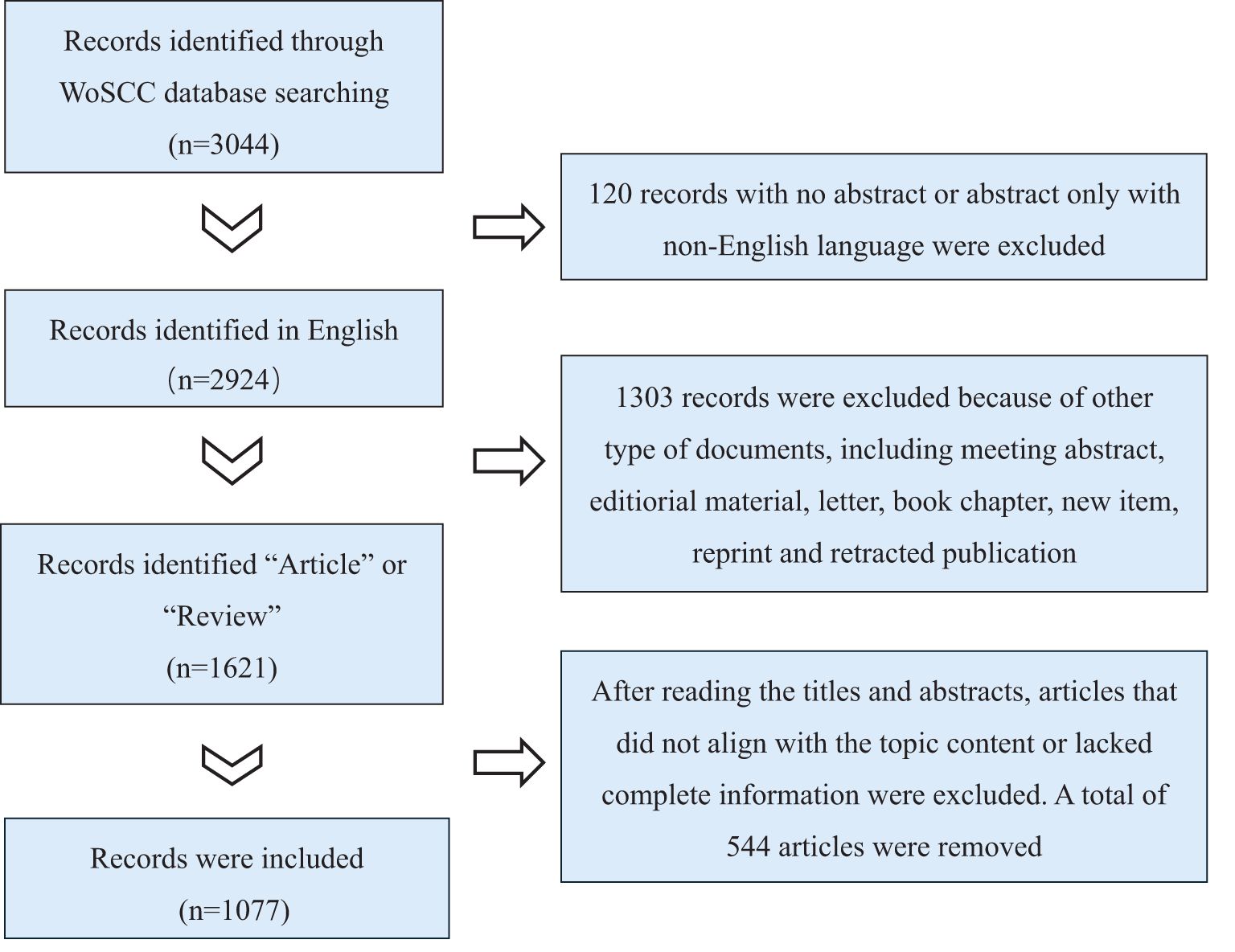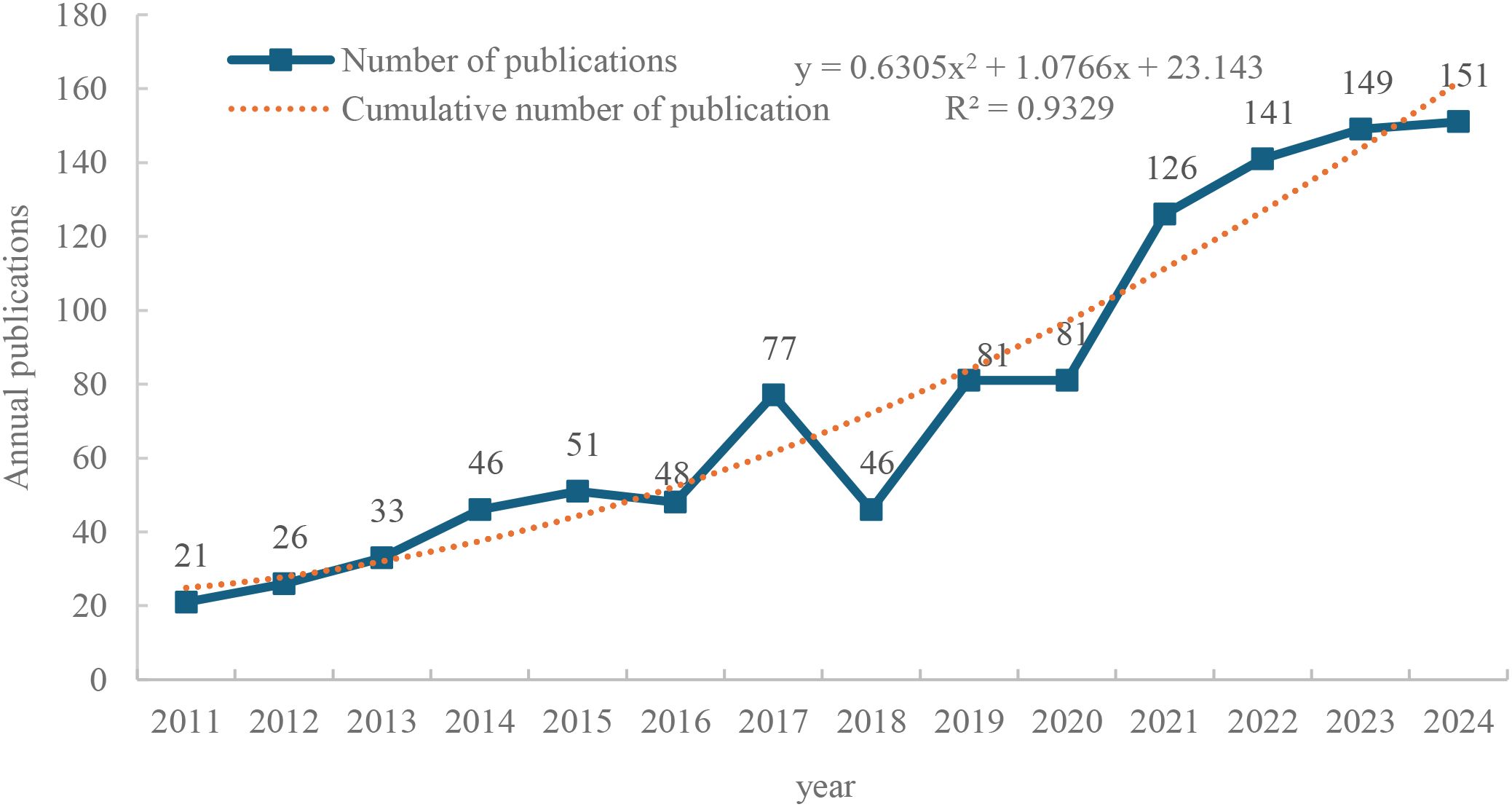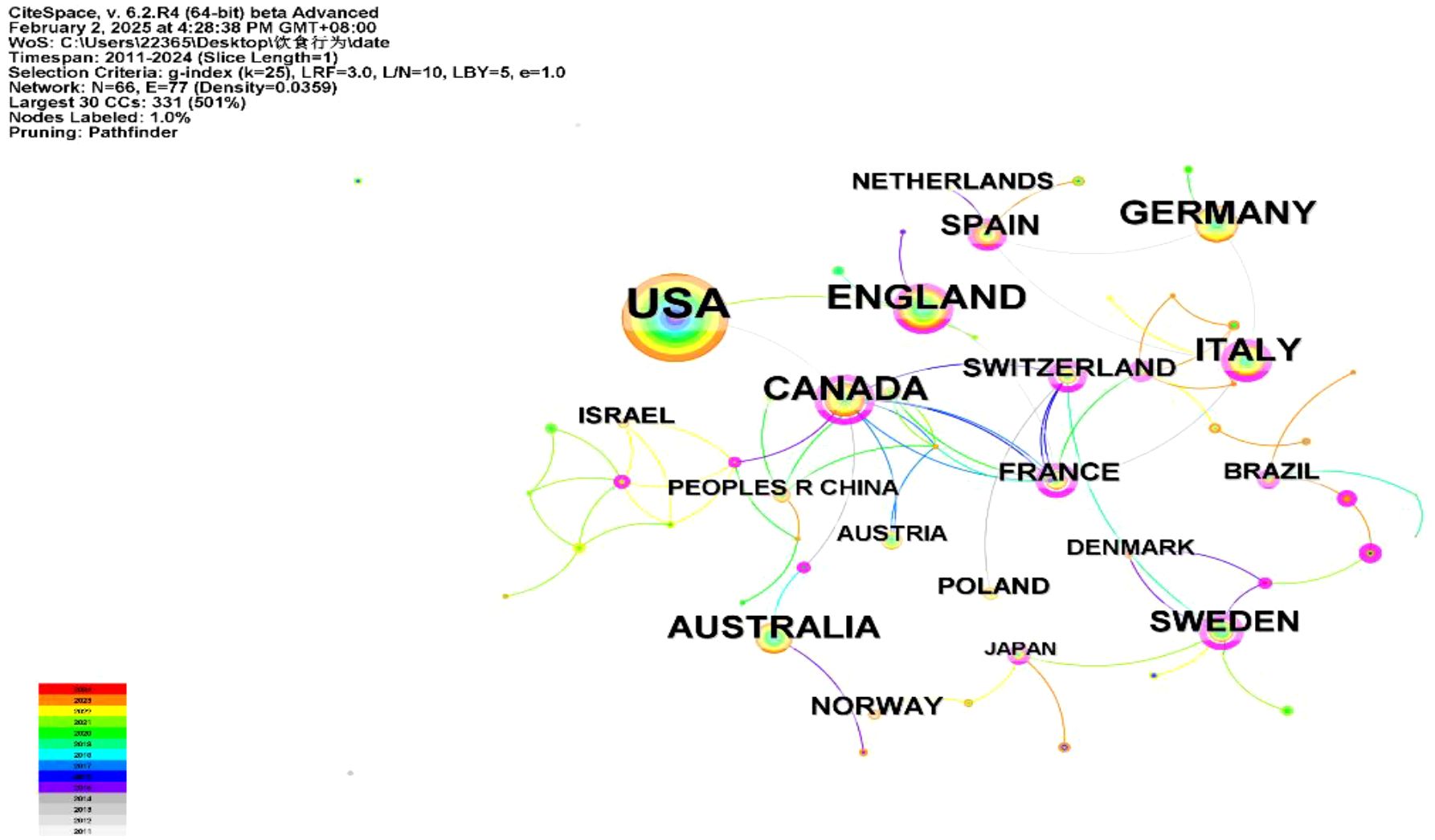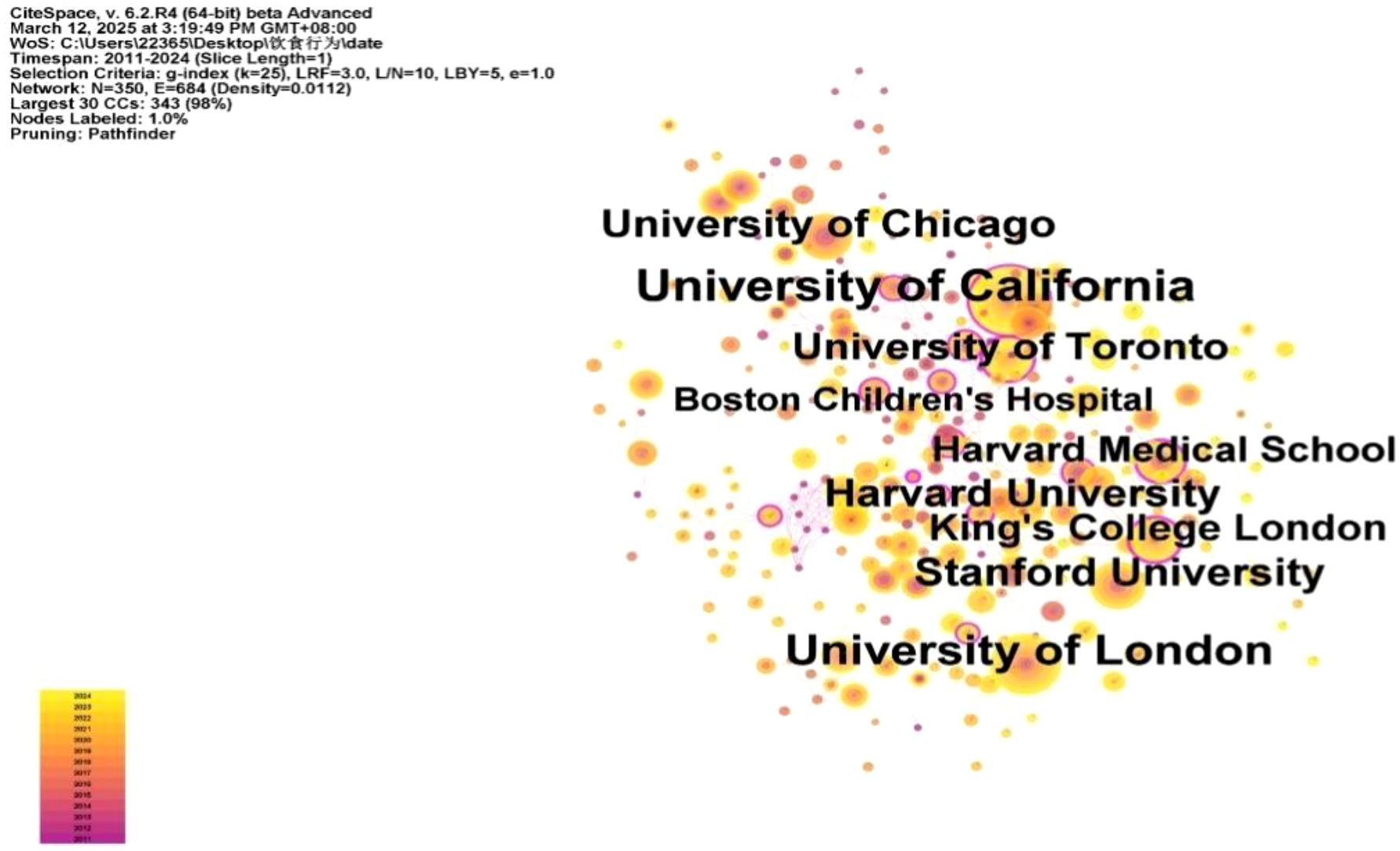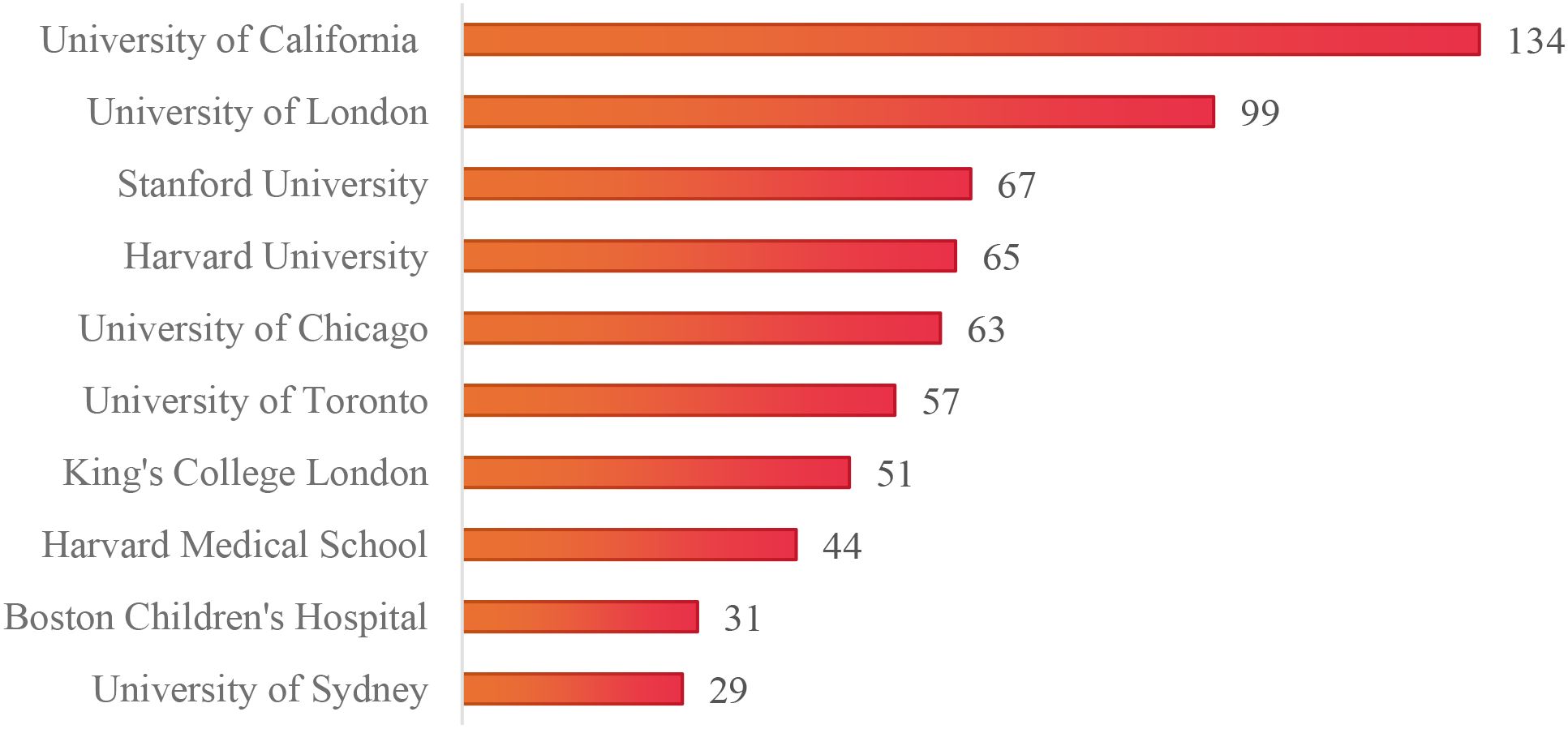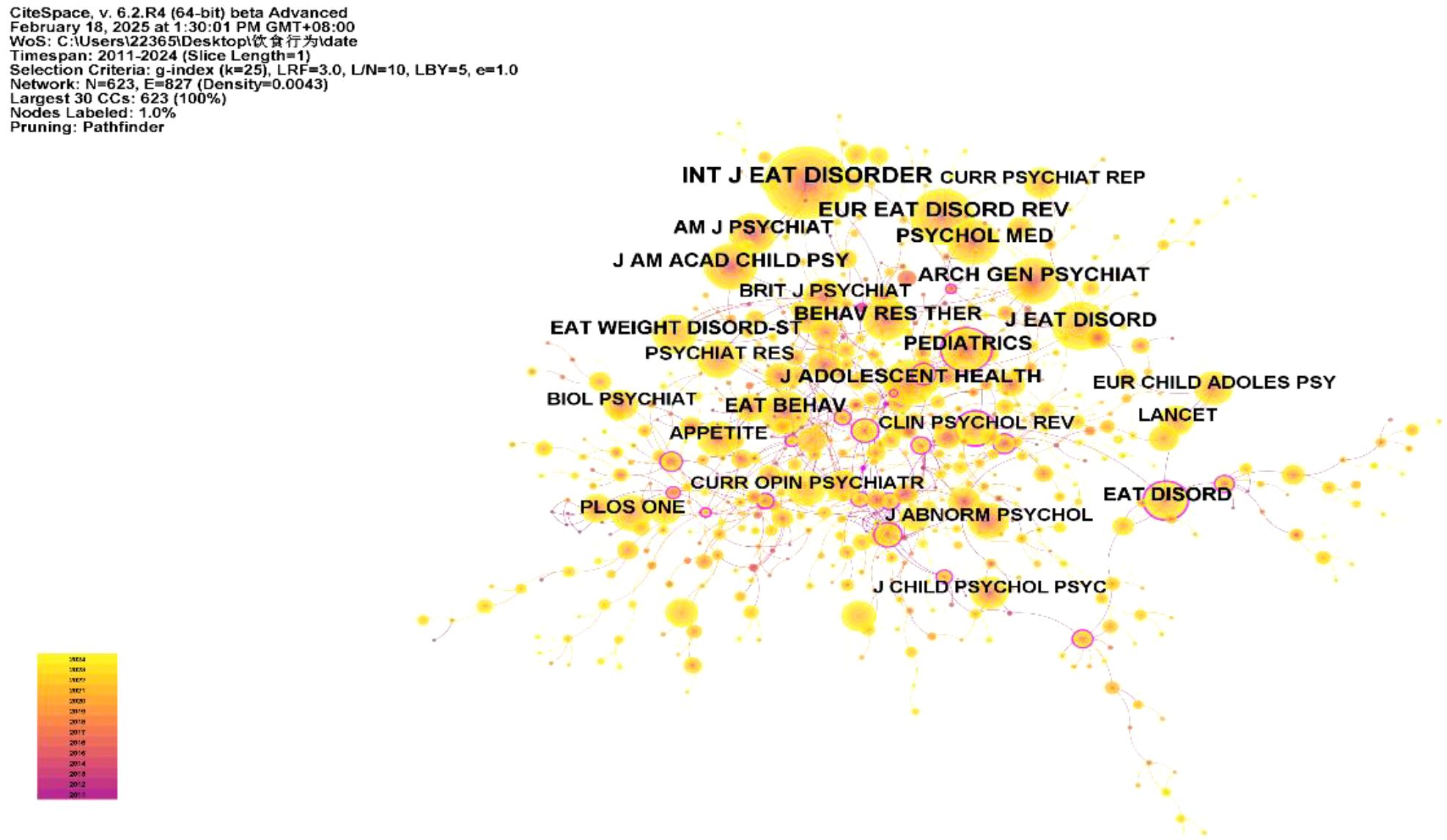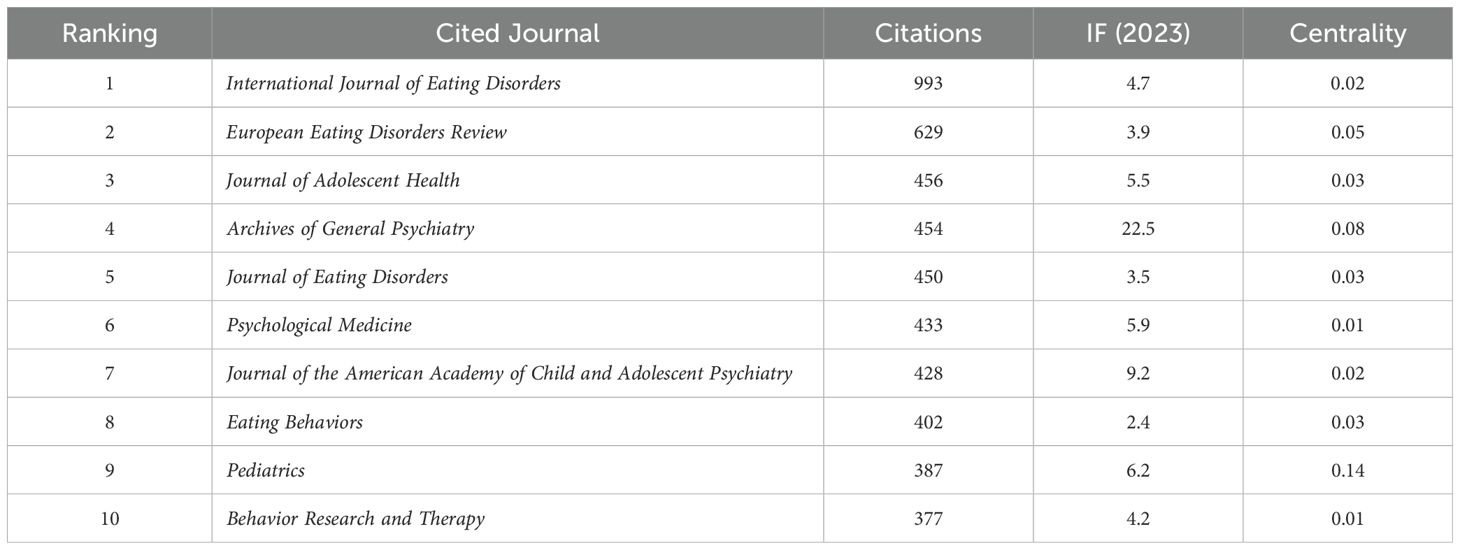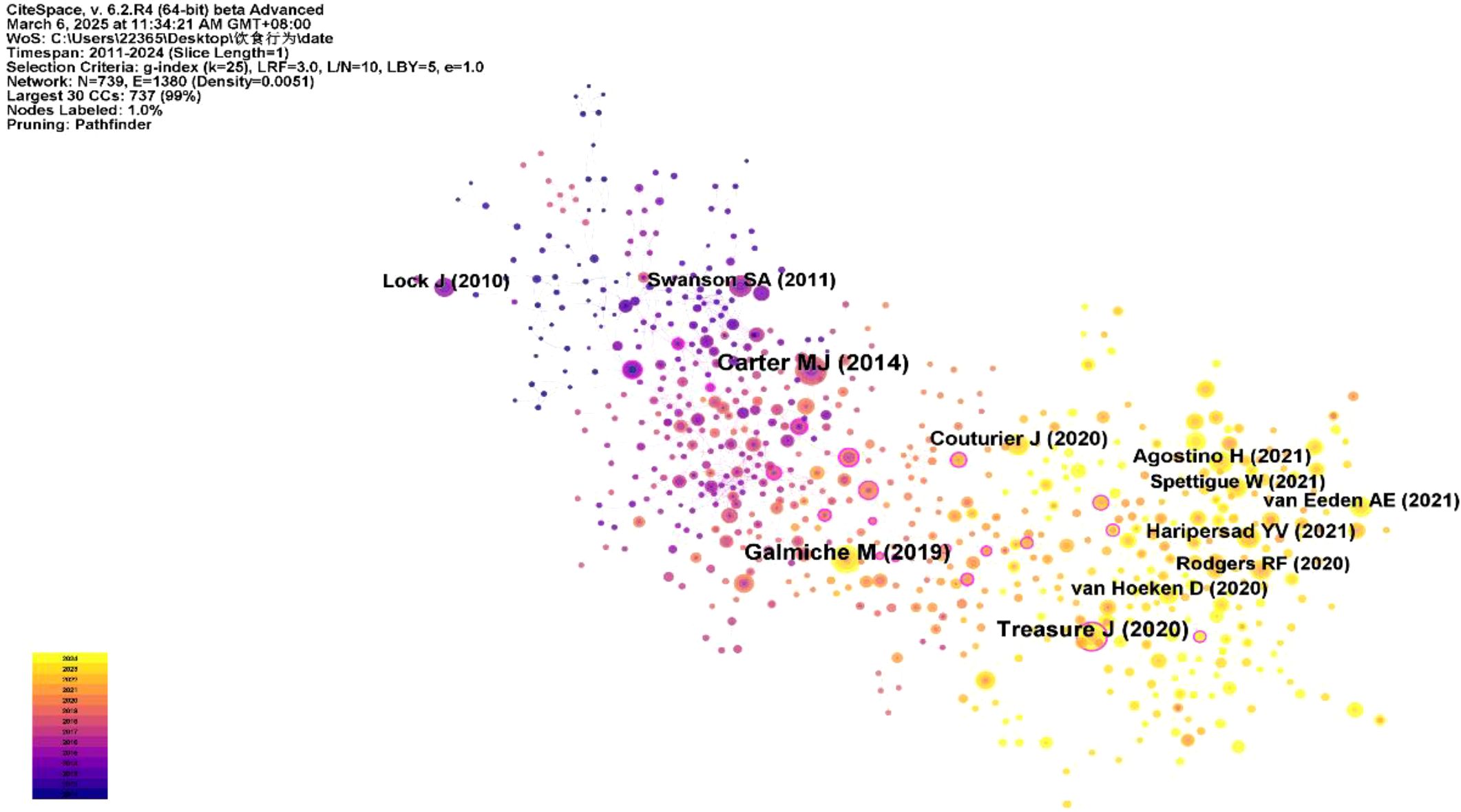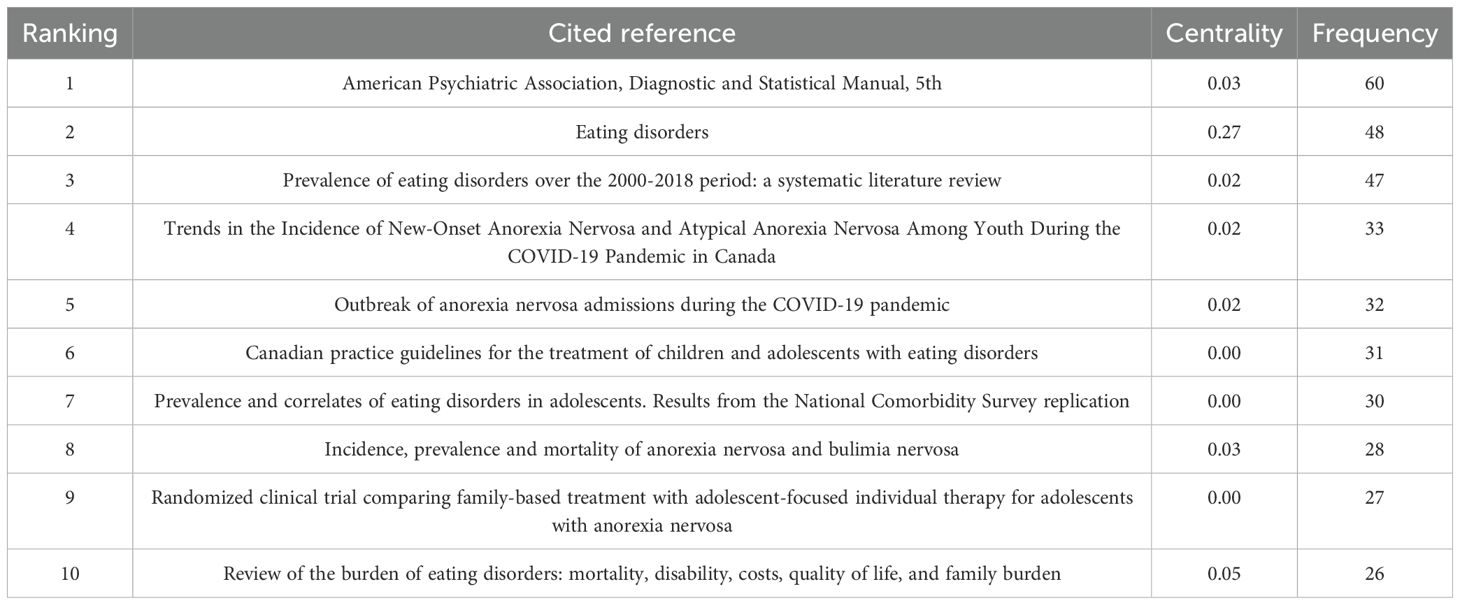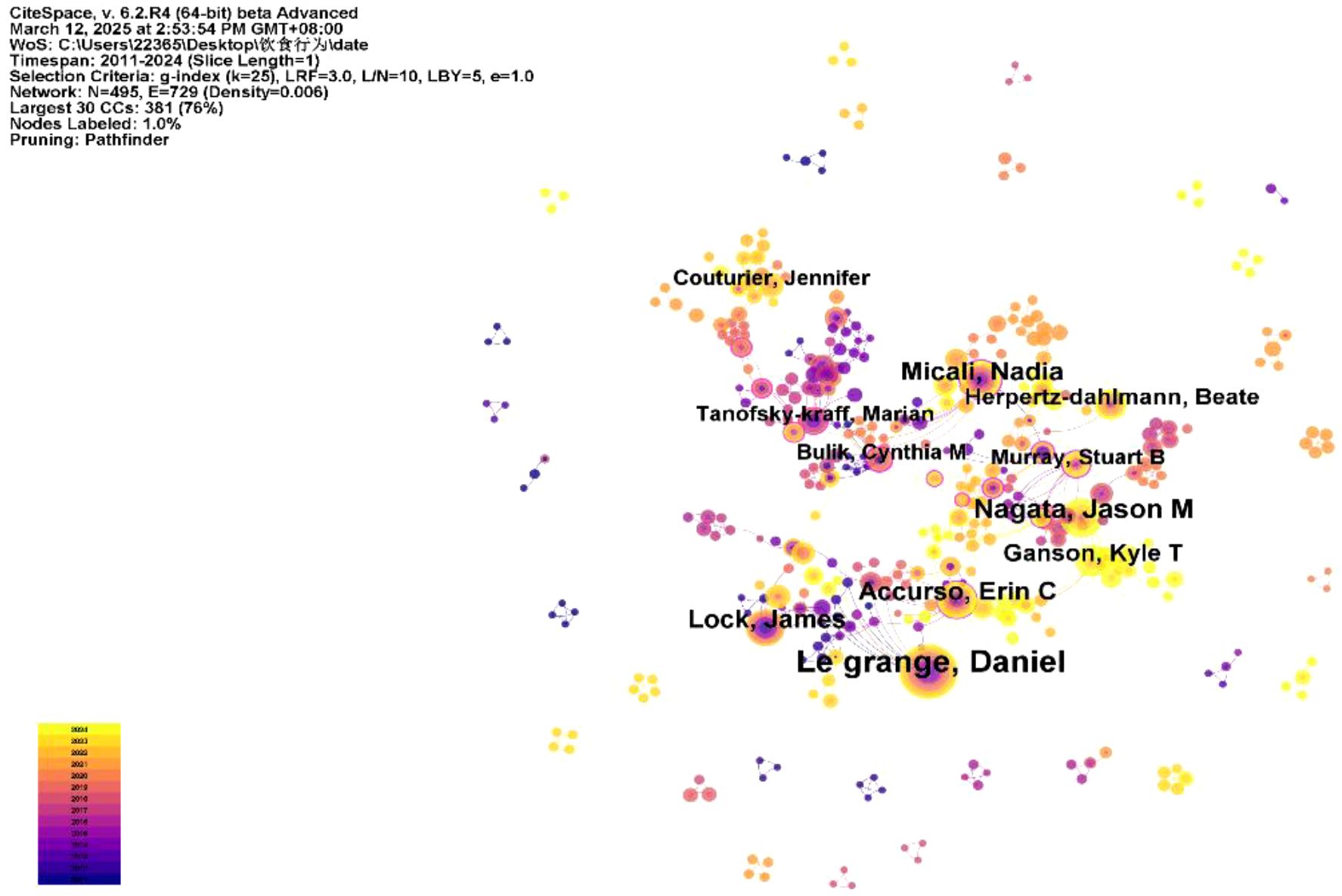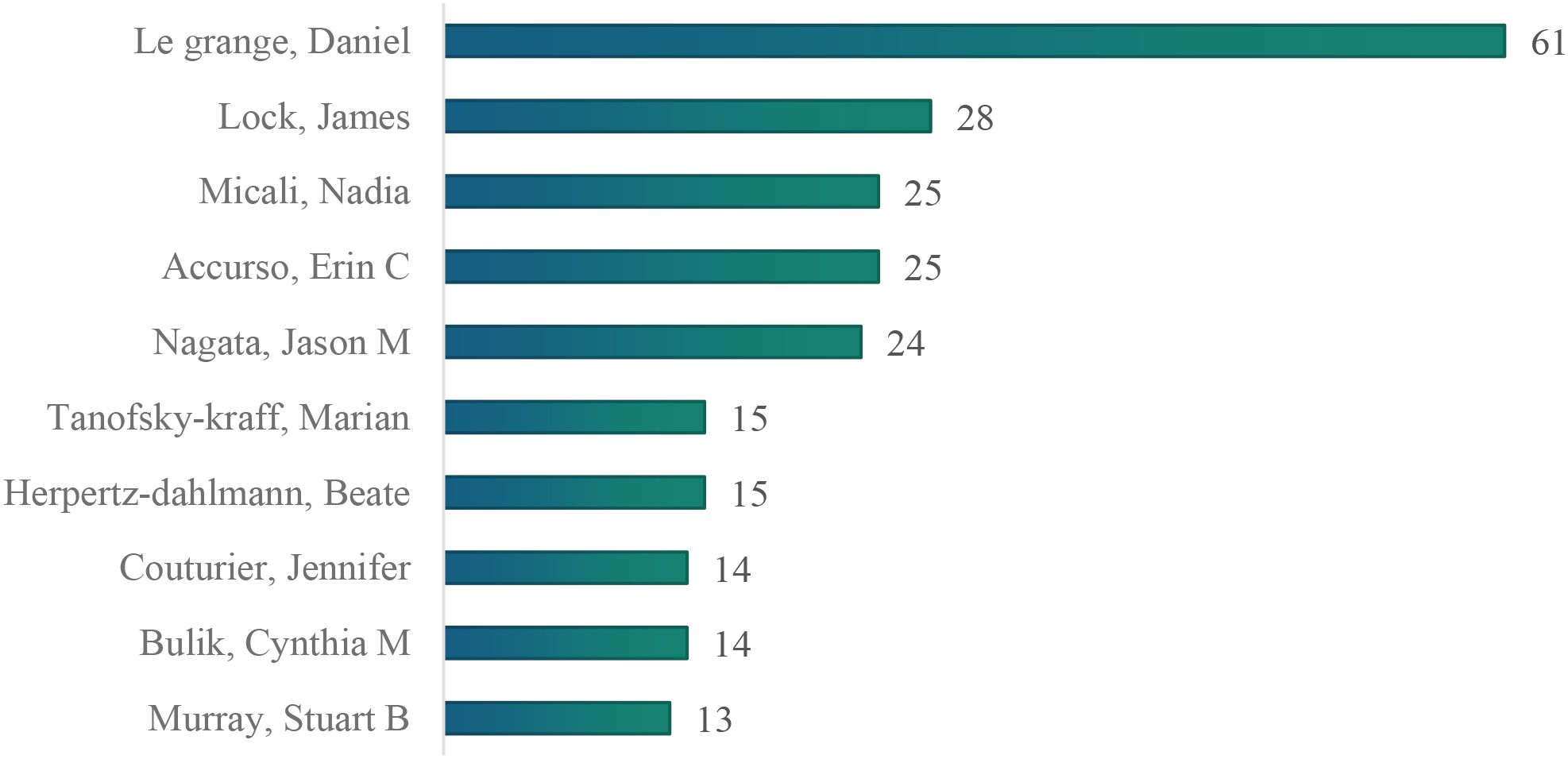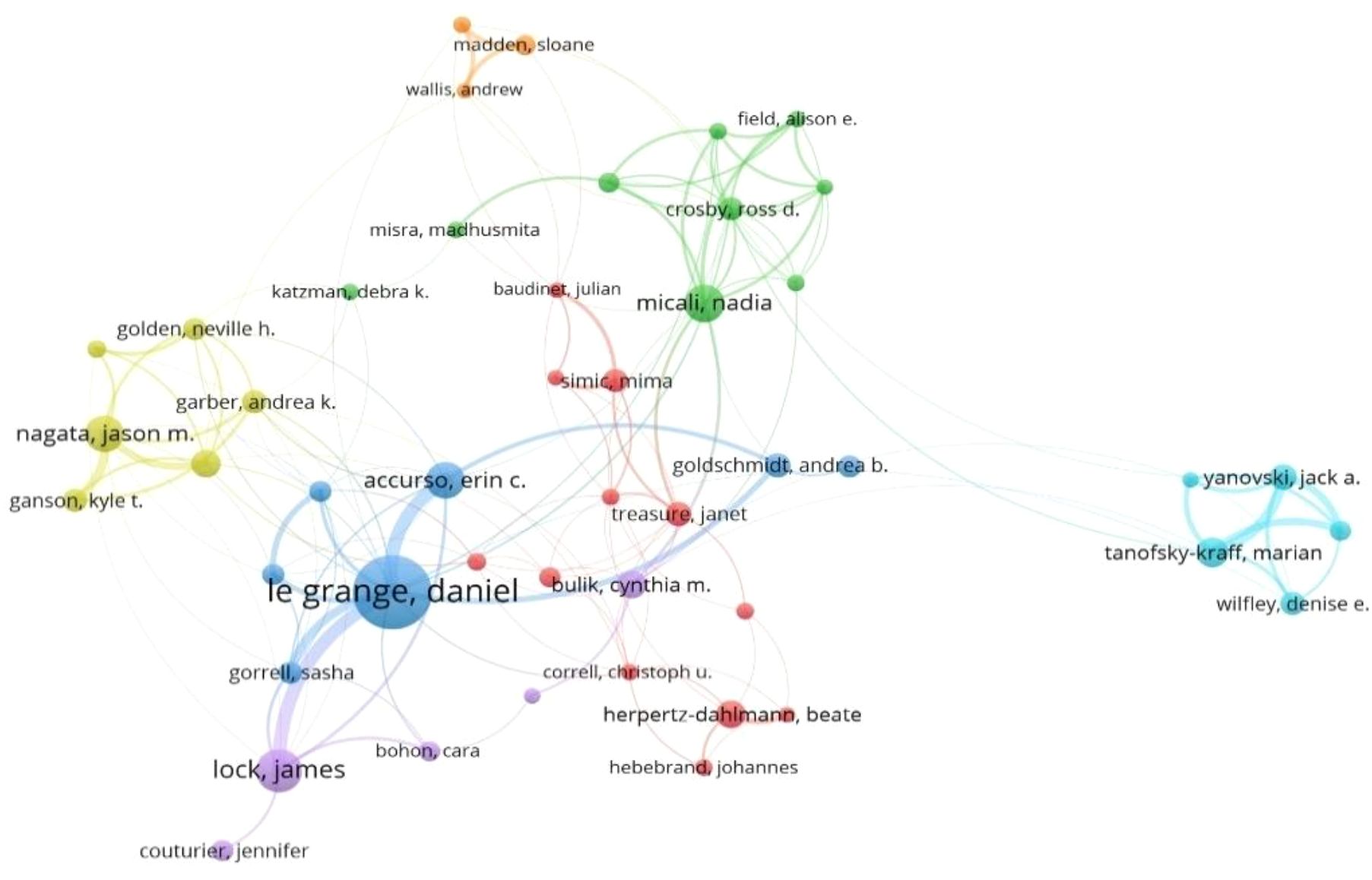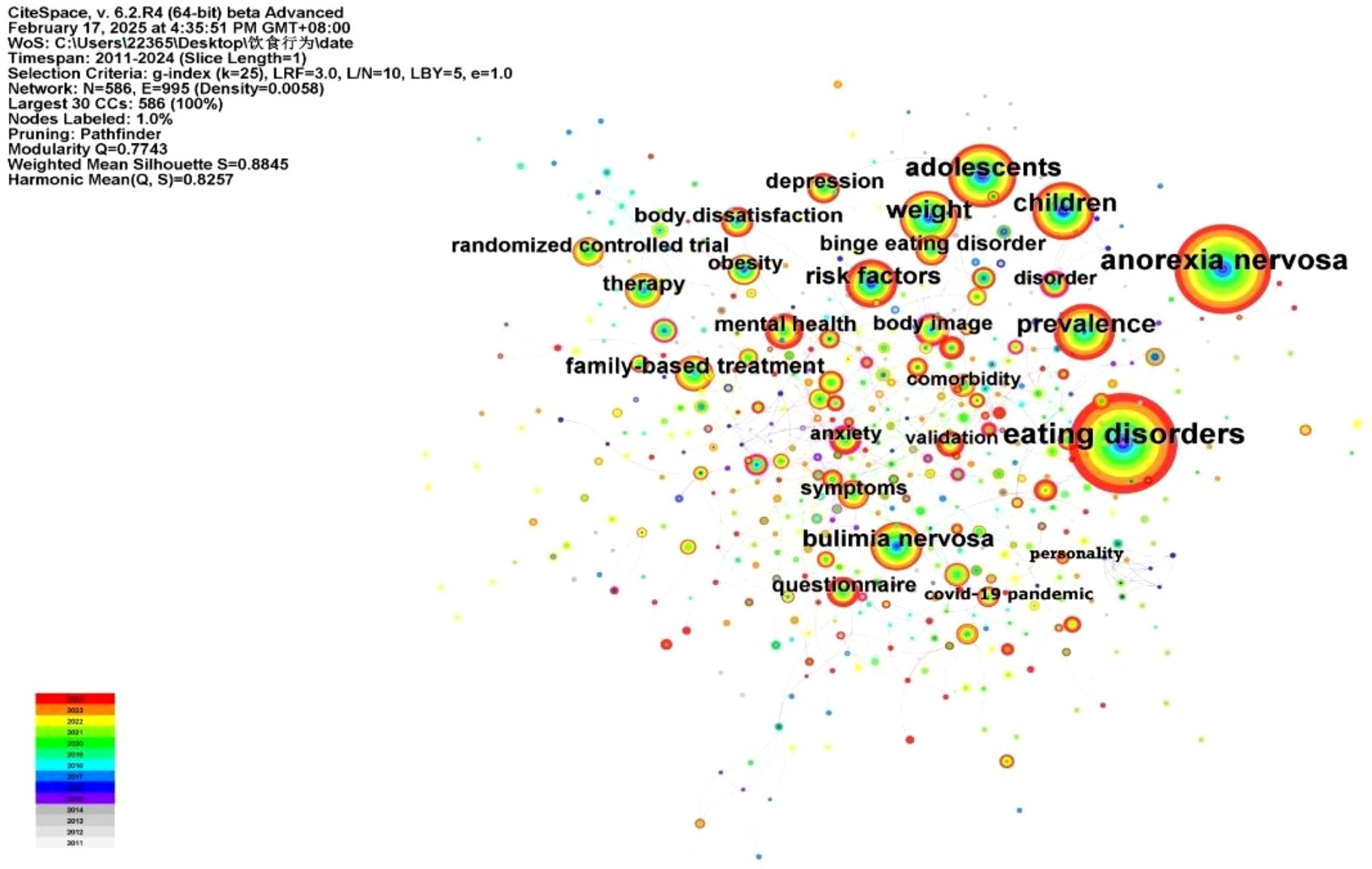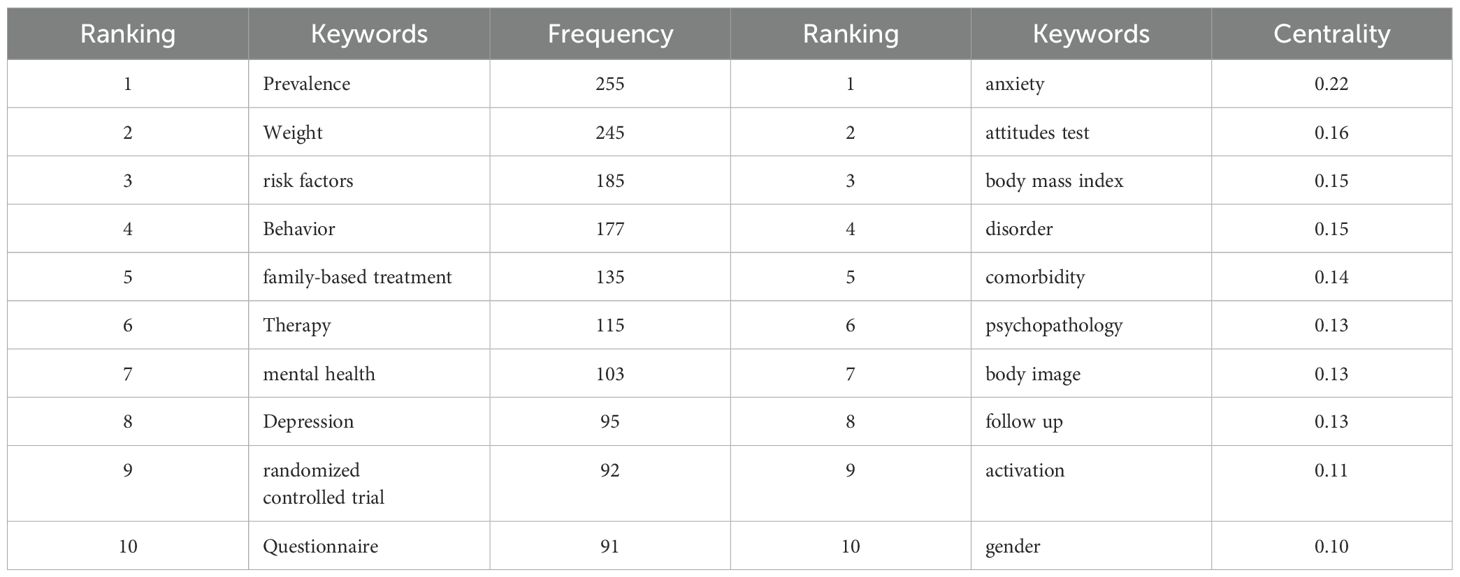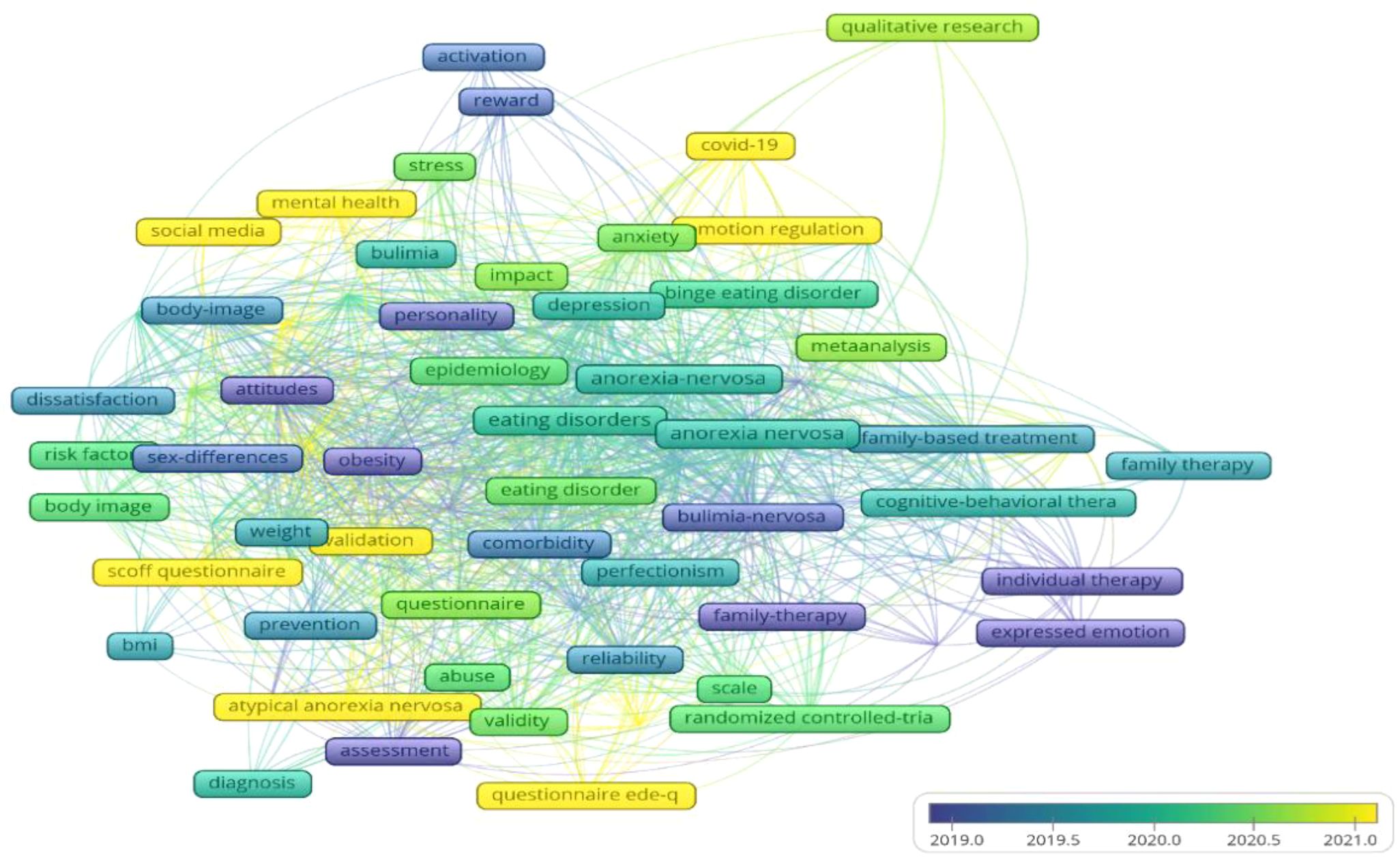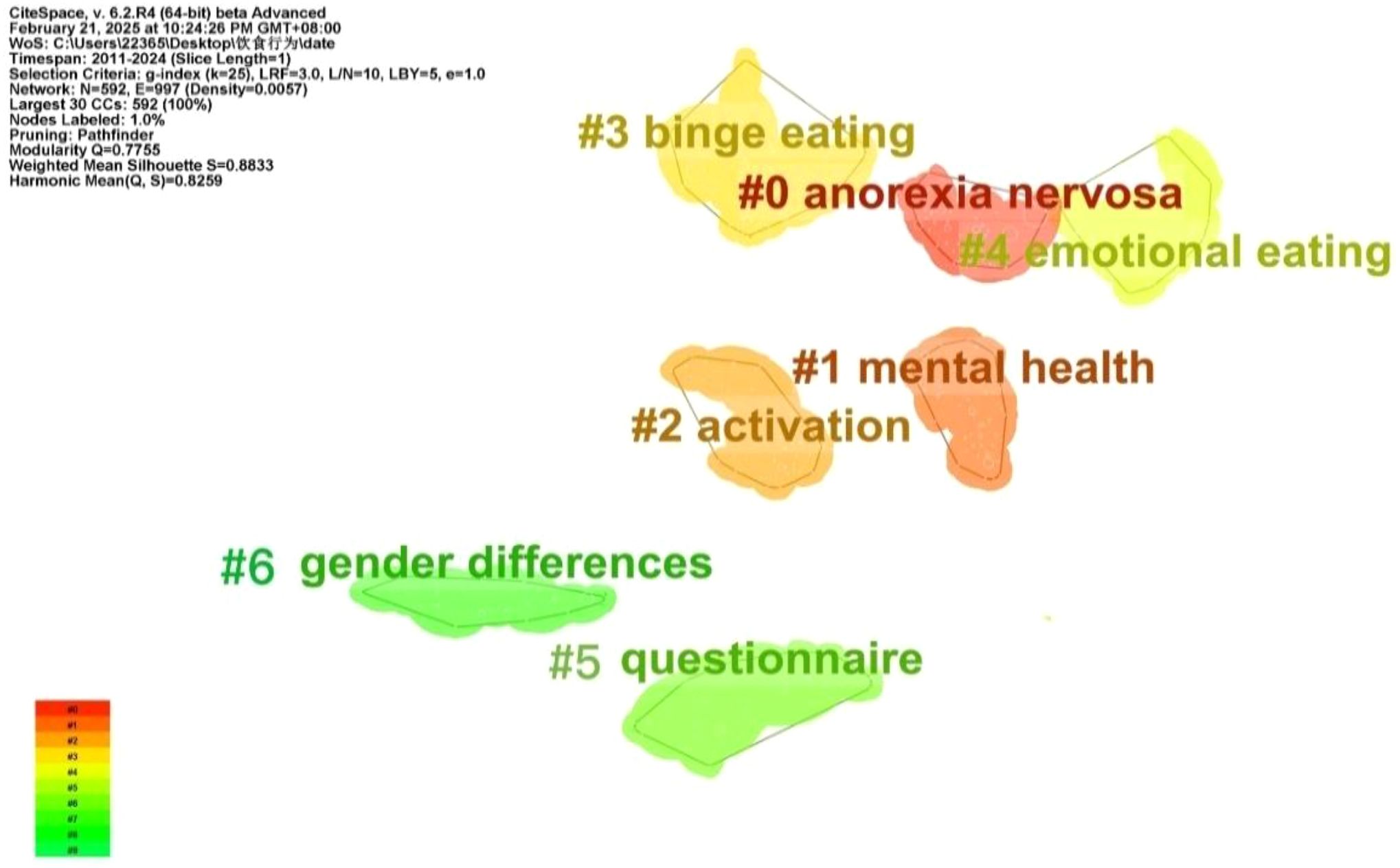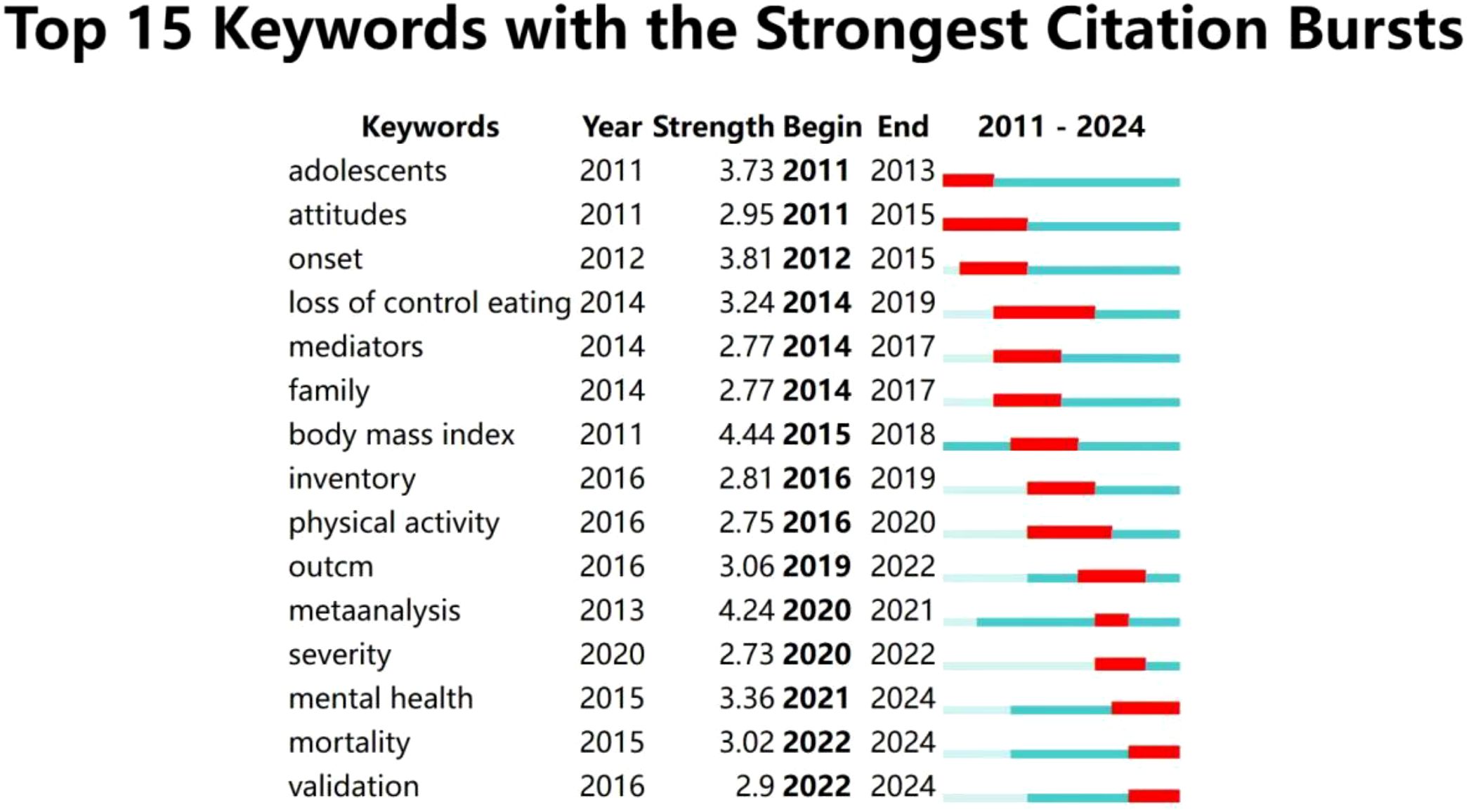- 1School of Nursing, Guangdong Pharmaceutical University, Guangzhou, Guangdong, China
- 2Department of Child & Adolescence Psychology, The Zhongshan Third People’s Hospital, Zhongshan, Guangdong, China
Background: Adolescent eating disorders represent a category of mental illness, marked by elevated mortality and morbidity rates and a significant adverse impact on the quality of life of both patients and their families. As one of the most important directions in eating disorders, adolescent eating disorders have significant research value, social value, and practical significance. Surprisingly, the overall research landscape in this domain has yet to be systematically explored through bibliometric analysis. Consequently, this study aims to employ bibliometric methods to analyze published literature, providing a comprehensive and systematic summary of the current research advancements and hotspots in the field of adolescent eating disorders, as well as to forecast potential research directions and future trends.
Methods: We retrieved studies related to adolescent eating disorders from the Web of Science Core Collection database, covering the period from January 1, 2011, to December 31, 2024. We conducted a bibliometric analysis of the literature, employed the visualization tools CiteSpace and VoSviewer. Our study focused on the number of publications, countries, institutions, journals that have cited the works, references, authors, and keywords, to uncover patterns and trends in the field.
Results: A total of 1,077 articles were retrieved. The number of publications in this field has shown a steady upward trend. The United States leads in adolescent eating disorder research. The University of California is the most productive institution, with 134 papers. The International Journal of Eating Disorders is the most cited journal, with 993 citations. The reference “American Psychiatric Association, Diagnostic and Statistical Manual, 5th” has the highest citation frequency. Le Grange Daniel is the most prolific author. High-frequency keywords include “prevalence”, “weight”, and “risk factors”. Emerging keywords are “mental health”, “emotion management”, “social media”, and “validation”.
Conclusions: Adolescent eating disorders are gaining increasing global attention. Presently, research on this issue focuses on comorbidities between adolescent eating disorders and other mental illnesses, and their etiology, risk factors, and clinical assessment. In the future, the core research directions in this field will center on verifying the long-term effectiveness of eating disorder treatments, refining personalized assessment and treatment models, and furthering interdisciplinary integration in interventional approaches.
1 Introduction
Eating disorders are a range of psychological conditions characterized by abnormal eating behaviors and an excessive preoccupation with weight and body shape (1). These disorders can lead to severe health problems (2). According to the Diagnostic and Statistical Manual of Mental Disorders, Fifth Edition (DSM-5) (3), the main types of eating disorders include anorexia nervosa (AN), bulimia nervosa (BN), binge eating disorder (BED), avoidant/restrictive food intake disorder (ARFID), pica, and rumination disorder. These conditions often emerge during adolescence or early adulthood (1). Globally, the lifetime prevalence of eating disorders in adolescents and young adults is between 0.6% and 26.7% (4). A 2011 US-based cross-sectional survey of adolescents found that the prevalence of anorexia nervosa, bulimia nervosa, and binge-eating disorder was 0.3%, 0.9%, and 1.6%, respectively (5), and these conditions were more common in females than in males (6). Many risk factors for eating disorders in adolescents have been identified, including age, gender, BMI, weight, mental health, and family and social environment. This is likely because adolescents are in a critical stage of physical and psychological development. Their cognitive control is not fully mature, and their emotional regulation mechanisms are relatively fragile, making them more vulnerable to eating disorders than other age groups (7). In addition, eating disorders can lead to serious consequences, such as non - suicidal self - injury, suicidal ideation, and suicidal behavior (8, 9). Recent studies have found a significant link between the duration of eating disorders and an increased risk of early-onset executive dysfunction, particularly in the core areas of decision-making, inhibitory control, and cognitive flexibility. This impairment can undermine the daily functioning of individuals with eating disorders, thereby increasing the risk of self-harm and suicide (10). Furthermore, SJ and colleagues’ research shows that among adolescents with bulimia nervosa and binge-eating disorder, 34% to 53% have experienced suicide attempts during their illness (11). Eating disorders can also lead to other health problems, such as depression, obesity (12), anxiety, OCD, diabetes (13), and renal failure (14). For adolescents with eating disorders, these problems mainly affect their mental and physical well-being. Cumulative research has found that adolescents with eating disorders are more likely to develop mental health problems such as depression, anxiety, and OCD later in life (15–17). It should also be noted that eating disorders can co-occur with other mental disorders, like depression, and worsen depressive symptoms. Currently, psychotherapy is the main treatment for adolescent eating disorders. However, due to economic and geographical factors, only a small number of patients receive effective treatment. In summary, eating disorders in adolescents can significantly impact their academic performance, daily life, and overall development. Therefore, exploring adolescent eating disorders is a significant research direction.
In recent years, adolescent eating disorders have gradually attracted extensive attention from the academic community, with research spanning an increasingly broad range of fields. This issue has expanded beyond the traditional realm of psychiatry to encompass multiple disciplinary dimensions, including psychology and sociology. A significant portion of studies, including several systematic reviews, have conducted in-depth explorations into the prevalence of adolescent eating disorders (18), as well as their risk factors, diagnosis (19), assessment (20), and treatment (21). However, existing studies often focus on narrow aspects and have failed to provide a comprehensive and systematic examination of the evolving trajectory of research on adolescent eating disorders. Meanwhile, with the rapid increase in relevant literature, researchers are confronted with the growing difficulty of obtaining key information and the challenge of accurately grasping the core conclusions of current research and future directions (22). Therefore, there is an urgent need for innovative methods to integrate the knowledge system of published studies, thereby fully and objectively analyzing the knowledge evolution and thematic trends in the field of adolescent eating disorders. Bibliometric analysis is a statistical method for analyzing literature that includes both qualitative and quantitative assessments. It can cluster and analyze detailed information of a specific research field, such as the number of publications per year, countries, institutions, journals, authors, and keywords. This method is capable of revealing the knowledge structure of a particular academic domain. By employing techniques such as data mining, information processing, statistical analysis, and mapping, it visualizes the evolution of knowledge communities. This helps scholars understand the academic achievements in their research area and identify future research directions (23, 24). Numerous bibliometric analyses focusing on adolescent populations have been conducted globally (25), highlighting the significant role of bibliometrics in this field. For instance, studies have examined issues such as adolescent insomnia (22), non - suicidal self – injury (26), and the comorbidity of overweight/obesity and depression in children and adolescents (27). However, to date, no bibliometric analysis has specifically investigated publications related to adolescent eating disorders. Therefore, we aim to apply the same methodology to conduct a bibliometric review of this domain. Through this comprehensive and objective synthesis and summary of the current research landscape, hotspots, and developmental trajectories, we hope to provide a valuable reference for researchers interested in this field.
Our primary aim is to conduct a comprehensive scientometric analysis of the evolving research trends in adolescent eating disorders over the past decades by using co-occurrence keyword networks. Our secondary objective is to provide researchers with a set of metrics and performance analyses for collaborative networks (including countries, institutions, authors, journals, references, and keywords).
2 Methods
2.1 Data sources
The literature data analyzed in this study were sourced from the Web of Science Core Collection (WoSCC) database, which is widely recognized internationally (28). This database was selected for its authoritative and comprehensive nature in the fields of bibliometrics and literature visualization (29). The systematic data collection approach employed by WoSCC has been widely acknowledged and applied in numerous studies (30). Additionally, to avoid bias caused by daily updates to the database, all literature searches and downloads for this study were completed on the same day (all data were retrieved on March 12, 2025).
2.2 Search strategy
Literature was retrieved online from the WoSCC database, and the retrieval process yielded 3,040 results for the period from January 1, 2011, to December 31, 2024. The search query used was TS = ((“adolescen*” OR “teen*” OR “youth*” OR “young*” OR “juvenile*” NOT “adult”) AND (“eating disorder*” OR “bulimia nervosa” OR “binge eating” OR “anorexia nervosa”)).
2.3 Inclusion/exclusion criteria
Two researchers independently screened the literature by reading titles and abstracts, cross-validated the results, and excluded studies unrelated to adolescent eating disorders. Disagreements were resolved through discussion with the first author. Inclusion criteria: 1) focus on adolescents with eating disorders; 2) English language; 3) article or review type. Exclusion criteria: 1) mismatched topic or population; 2) conference papers, abstracts, or duplicates. All records meeting the inclusion and exclusion criteria were exported, converted into plain text files named in the “download_XXX.txt” format, and imported into CiteSpace (version 6.2.R3) and VOSviewer (version 1.6.20) for analysis. After manual screening and deduplication in CiteSpace, 1,077 English-language papers were obtained (Figure 1).
2.4 Analysis tool
CiteSpace is a visualization tool developed by Professor Chaomei Chen (31). In this study, CiteSpace was used to conduct co-citation analyses of countries, institutions, and authors, as well as co-occurrence analyses of cited journals, references, and keywords. Additionally, cluster and burst analyses of keywords were performed. The specific parameter settings are as follows: period (from January 2011 to December 2024, with each slice being one year), term sources (titles, abstracts, author keywords, and keyword extensions), pruning (Pathfinder), node types (authors, institutions, countries, keywords, references, and cited journals), and other parameters are set as default (link retention factor: LRF = 3.0; e - value: e = 1; look - back years: LBY = 5; strength: cosine; range: within - slice; g - index: k = 25; top N items: 50; top N%: 10.0%; maximum number of items per slice: 100; visualization: cluster view - static and display merged network). CiteSpace integrates key information such as burst detection, betweenness centrality, and co-occurrence networks, which can be used to visualize the current state, hotspots, and frontier areas of research. In different co-occurrence maps, nodes represent countries, institutions, authors, cited journals, references, and keywords. The size of the nodes reflects their frequency of occurrence or citation, the color of the nodes indicates the year of occurrence or citation, and the lines between nodes signify collaborative or co-citation networks (32). The burst detection algorithm is an effective tool for capturing a sharp increase in citations and keywords over a specific period. In this mapping, the blue line represents the time interval, while the red line indicates the period during which the burst of citations and keywords occurs.
VOSviewer, developed by the University of Leiden in the Netherlands (33), was used in this study to construct network maps of authors and keywords. Nodes in these maps represent authors and keywords, with their colors distinguishing different clusters within the network. Various clusters symbolize potential research groups in author collaboration networks or keyword clusters. The width of lines between nodes indicates the degree of author collaboration or keyword co-citation. The data retrieved were imported into VOSviewer in plain text format. Parameter settings: minimum threshold of 15 publications for authors and 13 occurrences for keywords.
Microsoft Office Excel 2019 was used to create annual publication trend charts for different countries and to generate tables for the information needed in this article, including data on productive countries, institutions, cited journals, references, authors, and keywords.
3 Results
3.1 Annual global publication outputs
A total of 1,077 English-language articles were included in this study, as shown in Figure 2. The number of publications increased from 21 in 2011 to 151 in 2024. Although the growth trend of publications from 2011 to 2020 exhibited minor fluctuations, the annual publication volume remained below 100 articles during this period. It was not until 2021 that there was a noticeable increase in publication volume. The annual increase in publications from 2021 to 2024 was much more substantial than in the preceding years, suggesting that adolescent eating disorders in the post-Coronavirus Disease 2019 (COVID-19) era have become one of the emerging research hotspots among scholars. In addition, Microsoft Excel was employed to visualize the annual number of published papers, with a trend line added to forecast future publication volumes. The predictive growth model is represented by the equation y = 0.6305x² + 1.0766x + 23.143, where x denotes (forecast year - 2011) and y represents the projected annual number of publications. Moreover, the curve of function fitting indicates a significant correlation between the annual growth trend and the years of publication output (R²= 0.9329), suggesting that the number of future studies in this field will continue to rise.
3.2 Country analysis
We used CiteSpace to generate a national co-citation network map (Figure 3). In the map, circles symbolize countries, with larger circles indicating more publications. The lines between circles represent connections between countries. The map contains 66 nodes and 77 links, with a network density of 0.0359, showing frequent international collaboration. Betweenness centrality, marked by purple rings whose thickness denotes the level of centrality, reflects a country’s research significance. The US led the research with 461 papers (43.36%). England and Germany ranked second and third, with 142 (13.18%) and 117 papers (10.86%). France (0.90), Switzerland (0.79), and Sweden (0.72) had the highest centrality, indicating their authority and prominence in the field (Table 1).
3.3 Institutional analysis
This study encompassed 343 research-related institutions (Figure 4). The network had 343 nodes and 1,891 links, with a density of 0.0322, indicating close institutional cooperation. Institutions such as universities and specialized pediatric and adolescent hospitals are key players in adolescent eating disorder research. The University of California tops the list with 134 papers (12.44%), followed by University College London (99, 9.19%) and Stanford University (67, 6.22%) (Figure 5). The University of California and University College London have formed a stable recent collaboration, focusing on child and adolescent mental illness and neurodevelopment. The former emphasizes neuroscience and technological aspects (e.g., brain-computer interfaces), while the latter integrates epidemiology and psychological theories. Spatially, the institutions are mainly in economically developed European and American countries, with few in developing nations, which limits the research scope but also offers new directions for future studies.
3.4 Cited journal analysis
We used CiteSpace to conduct a co-occurrence analysis of journal citations (Figure 6). The top 10 cited journals are shown in Table 2. The most-cited journal is the International Journal of Eating Disorders (n=993), followed by European Eating Disorders Review (n=629) and Journal of Adolescent Health (n=456). These journals are all classified in the JCR Q2 quartile in the 2023 Journal Citation Reports, indicating that the articles they publish are of high quality and that the studies featured in these journals are reliable in terms of their impact and representativeness.
3.5 References analysis
The co-occurrence map of references is shown in Figure 7, with the top 10 most-cited references listed in Table 3. The map includes 739 nodes and 1,380 links. Nodes range in color from deep purple to light yellow, indicating an increasing sequence of publication years, with larger nodes representing higher numbers of publications. Lines signify connections between nodes. The reference “American Psychiatric Association, Diagnostic and Statistical Manual, 5th” has the highest citation frequency (n=60) (34). The reference with the highest betweenness centrality is the article “Eating disorders” published in The Lancet.
3.6 Author analysis
A total of 495 authors contributed to the 1,077 English-language articles. According to bibliometric analysis, the research follows Lotka’s Law, with the majority of authors (72.53%) publishing ≤2 papers, while a small number of authors have contributed the majority of research outcomes. The minimum publication threshold for core authors in this field is calculated as M≈ 0.749×√Nmax (where M represents the minimum number of publications for influential authors, and Nmax is the publication count of the most prolific author, with Nmax = 61 in this dataset). Therefore, authors who have published six or more papers are identified as core authors. A total of 57 core authors were identified, who collectively published 564 papers, accounting for 52.36% of the total number of papers, meeting the criterion of Price’s Law that core authors should contribute more than 50% of the total publications. Using CiteSpace for visual analysis, each node represents an author, with larger nodes indicating more published papers. Lines between nodes signify author collaboration, with thicker lines representing closer collaboration. The map shows 495 nodes and 729 links, with a network density of 0.006 (Figure 8). Le Grange Daniel is the most prolific author with 61 publications (Figure 9), followed by Lock James (n=28), Micali Nadia (n=25), Accurso Erin C (n=25), and Nagata Jason M (n=24). However, the lack of dense connections between authors indicates that research teams in the field of adolescent eating disorders tend to work independently with relatively limited collaboration (Figure 10).
3.7 Keywords analysis
3.7.1 Co-occurrence analysis
Using CiteSpace, we performed a co-occurrence analysis of keywords related to adolescent eating disorders (Figure 11). In the resulting map, there are 586 nodes and 995 links, giving a network density of 0.0058. Each node stands for a keyword, with larger nodes indicating higher keyword frequency. After removing the topic words “eating disorder”, “bulimia nervosa”, “binge eating”, and “anorexia nervosa”, Table 4 lists the top 10 keywords ranked by frequency and centrality. These keywords cover the etiology, risk factors, comorbidities, assessment, and interventions for adolescent eating disorders. The overlay visualization of keywords is shown in Figure 12.
3.7.2 Cluster analysis
On the basis of the keyword co-occurrence analysis, the likelihood ratio (LLR) algorithm was used to cluster keywords by homogeneity. The cluster analysis map includes 592 nodes and 997 links, with a network density of 0.0057. CiteSpace evaluated the network structure quality and cluster clarity using the modularity value (Q) and average silhouette value (S). In this study, Q was 0.7755 (Q > 0.3 indicates a significant modular structure), and S was 0.8833 (S > 0.5 indicates that the clustering results are reasonable). The cluster analysis revealed the distribution of different research areas. Cluster size is inversely proportional to cluster number; larger clusters have smaller numbers. Thus, cluster #0 is the largest (31). In the co-occurrence network of adolescent eating-disorder keywords, seven clusters were identified (Figure 13). Cluster #1 “mental health” can assess interventions for such disorders; cluster #5 “questionnaire” shows their assessment methods; clusters #2 “gender difference”, #4 “emotional eating”, and #6 “activation” cover the etiology and risk factors; clusters #0 “anorexia nervosa” and #3 “binge eating” are the main research topics.
3.7.3 Burst detection analysis
Burst detection analysis can quickly identify keywords whose frequency of occurrence has significantly increased during a specific period, helping to reveal hotspots and trends in research fields. As shown in Figure 14, “body mass index” has the highest burst strength (4.44), indicating that it was a focal point for researchers from 2015 to 2018. The keyword with the lowest burst strength is “severity”(2.73), with a duration from 2020 to 2022. Looking at the timeline of research, different periods have seen different hotspots in adolescent eating disorder research. The year 2019 was a key turning point. Before 2019, the main focus was on demographic surveys and analyses of adolescent eating disorders. After 2020, the COVID-19 pandemic increased the prevalence and mortality rate of adolescent eating disorders, shifting the research emphasis to the validation of treatments for these disorders. The keywords highlighted in yellow-green and yellow in Figure 12 mark emerging trends in recent adolescent eating disorder research, such as “social media”, “mental health”, “emotion management”, and “COVID-19”.
4 Discussion
4.1 Major findings
This study employed visualization tools to analyze 1,077 articles in the field of adolescent eating disorders. The findings revealed that although the number of publications in this field has fluctuated over the past decade, there has been a significant increase since the outbreak of COVID-19. This surge is likely closely related to the containment measures implemented during the pandemic. Specifically, the enforcement of home-quarantine policies led to a substantial reduction in outdoor activities for adolescents. Prolonged periods of solitude and social isolation significantly heightened feelings of loneliness and psychological stress, thereby triggering or exacerbating eating-disordered behaviors (35). These conditions also induced psychological issues such as fear, anxiety, and loneliness among adolescents and increased their risk of depression. Consequently, adolescent eating disorders garnered considerable attention, resulting in a dramatic increase in research output and reaching an all-time high for the first time in 2021.
Visualizations of countries and institutions show that developed countries and institutions, represented by the US, have the highest publication output in eating disorder studies. This can be attributed to the following two factors. Firstly, diagnostic criteria for mental disorders, which are largely influenced by local psychiatric schools, originate primarily from high-income countries like the US, which leads to higher prevalence of reported rates in developed countries. Secondly, Western countries, including the US, have high GDP, abundant funds, advanced equipment, and a strong research system, which facilitates multidisciplinary collaboration and provides important platforms for global academic exchange. Moreover, the participation of developing countries is increasing, although country co-occurrence networks show that the burden of adolescent eating disorders is concentrated in high-income developed countries. Previous literature indicates that the burden of eating disorders is growing across all socio-economic index regions, particularly in developing countries (36). This trend suggests that future research focus may shift from developed to developing countries. This highlights the need for resource planning and prioritization of health policies. It also suggests that future efforts should strengthen cooperation and exchange between developing and developed countries to jointly address the global challenge of eating disorders in adolescence (37).
In terms of journal citations, the International Journal of Eating Disorders is the most cited (n=993). The top 10 journals mainly focus on pediatrics, psychology, and psychiatry but have relatively low impact factors, indicating that research quality in this field needs to be improved. The citations of articles in this field are increasing exponentially, with the top 10 articles each cited over 300 times. The American Psychiatric Association’s Diagnostic and Statistical Manual of Mental Disorders, 5th Edition, has the highest citation frequency. This manual provides detailed diagnostic criteria for eating disorders and other mental disorders (34). Second is the 2020 Lancet paper “Eating disorders” by Treasure et al., which discusses the high mortality, sociocultural causes, and new therapies (e.g., digital interventions) for eating disorders and points out gaps in early screening, comorbidity management, and intervention in current care systems (1). Regarding author productivity, Le Grange Daniel has the most publications (n=61), and Micali Nadia is the most influential author (centrality = 0.28). They are key figures in this field, and future research can build on their work for deeper exploration.
4.2 Analysis of research hotspots and trends in adolescent eating disorders
Based on keyword co-occurrence, clustering, and burst analysis, this study highlights the complex interplay between etiology, risk factors, clinical evaluation, management, and comorbidities in adolescent eating disorders. It underscores the need for a multi-faceted, multi-step, and multi-disciplinary approach in their research and management. The analysis shows that comorbidities, etiology, risk factors, assessment, and intervention for adolescent eating disorders are key focuses of academic attention.
4.2.1 Comorbidity
Comorbidity of eating disorders with other mental illnesses is a key focus in adolescent eating disorder research. Eating disorders often coexist with mental illnesses such as mood disorders, anxiety disorders, and personality disorders (38, 39). Adolescents with comorbid conditions tend to exhibit more severe psychiatric symptoms, and the interplay of potential mechanisms underlying these comorbidities may be an important factor leading to poor prognosis. Eating disorders can alter an individual’s cognitive state, causing an excessive preoccupation with eating and thus triggering anxiety. This not only increases the risk of developing psychological problems such as depression and anxiety but also heightens the likelihood of negative behaviors like suicidal ideation (8, 40). A study by Patel et al. (41) found that adolescents with comorbid eating and psychiatric disorders are much more likely to exhibit negative behaviors, especially suicidal ideation, compared to those with only psychiatric disorders. Depression and anxiety, as risk factors for eating disorders, can easily trigger eating symptoms. Adolescents face significant pressures during puberty, including concerns about body image (42), peer acceptance (43), and societal aesthetic standards (44), all of which often exacerbate the severity and persistence of these disorders (45). Moreover, a bidirectional relationship exists between eating disorders and these other conditions, with anxiety and mood disorders potentially preceding the development of eating disorders. For example, one study found that adolescents showing depressive symptoms in the first year of junior high school were at higher risk of developing eating disorder symptoms within the next 12 months (46). This bidirectional relationship complicates diagnosis and treatment because multiple underlying psychological issues need to be considered simultaneously during the therapeutic process. The diverse clinical manifestations of adolescent eating disorders, compounded by comorbid psychological problems such as depression and anxiety, further increase the complexity of diagnosis and treatment. Focusing solely on the eating disorder while neglecting underlying psychological issues often fails to achieve satisfactory therapeutic outcomes and may even lead to relapse. Therefore, future research and practice should place greater emphasis on early identification and intervention, which is of great significance for mitigating the long-term negative impact of eating disorders on adolescents’ physical, psychological, and social development.
4.2.2 Etiology and risk factors
Etiology and risk factors are key research focuses in the field of adolescent eating disorders. Researchers have long explored the causes of eating disorders from a neurophysiological perspective. For instance, one study indicated that eating disorders may be linked to serotonin receptor (5-HT2AR) and brain-derived neurotrophic factor (BDNF) genes (47). Da Luz Neto et al. (48) found an association between eating disorders and hypothalamic-pituitary-adrenal (HPA) axis dysfunction. Notably, a significant relationship exists between eating disorders and diabetes, particularly type 1 diabetes mellitus (T1DM). Adolescents with T1DM, due to the strict dietary control, weight fluctuations from insulin use, and the stress of constant blood glucose monitoring, are highly susceptible to body image dissatisfaction, excessive weight anxiety, and loss-of-control eating behaviors, which considerably increases their risk of developing eating disorders (49). In recent years, researchers have identified relevant factors from multiple perspectives, including gender, BMI, family, personality traits, psychological aspects, and environmental factors (50–52). Body image dissatisfaction (53), low self-esteem (54), emotional dysregulation, and impulsivity (55) are considered major risk factors for eating disorders. Moreover, environmental and sociocultural factors hold significant weight in eating disorder research. Factors such as the impact of sexual and gender minorities (56), social media use (57), and cultural beauty standards can influence adolescents’ mental health and behaviors in various ways. Therefore, a comprehensive understanding of the complex interplay between biological, psychological, and social factors is fundamental to developing effective preventive and personalized treatment strategies. Future research urgently needs to integrate multidimensional data to construct precise risk prediction models and to develop targeted intervention programs based on the individual needs of adolescents to enhance therapeutic efficacy.
4.2.3 Assessment
As a psychiatric disorder associated with high mortality, adolescent eating disorders are significantly linked to severe psychological distress, impaired social functioning, and multiple comorbidities. Despite their prominent clinical impact, global health systems generally struggle with low identification rates and substantial treatment gaps (58, 59). Multiple studies have emphasized the importance of integrating psychological, physiological, and family assessments during the diagnosis of eating disorders. Psychological assessment is a key component in the evaluation of adolescent eating disorders. Commonly used psychological assessment tools include the Eating Disorder Examination Questionnaire (EDE-Q) (60), the SCOFF questionnaire, and the Eating Attitudes Test (EAT-26). Among these, the EDE-Q and the SCOFF questionnaire have been culturally adapted and standardized for screening purposes in many countries (61–63). The Eating Disorder Examination (EDE) is a brief self-report tool that is crucial in identifying abnormal eating behaviors, body image disturbances, and cognitive distortions associated with adolescent eating disorders. It can be used in schools or for large-scale screening. Studies have shown that the EDE performs well in detecting cases and ruling out non-cases of more common eating disorders in primary care settings (64). In addition, medical assessment plays a vital role in adolescent eating disorders. Given that adolescents are at a critical stage of physical development, eating disorders can have a significant impact on their physical health, including malnutrition, electrolyte imbalances, delayed growth, and delayed puberty (65). Given these risks, comprehensive and ongoing medical assessment is crucial for addressing the severe physical consequences of eating disorders. Family dynamics also play a key role in the development, maintenance, and recovery from eating disorders, underscoring the importance of family assessment. Research has confirmed that family functioning is closely linked to the occurrence of eating disorders. Factors such as excessive emotional enmeshment, lack of boundaries, overprotection, or control within the family can influence individual mental health and behavioral patterns (66). Conducting family assessments and identifying potential family dysfunction are essential for developing effective interventions and promoting patient recovery. Family-based assessment can improve treatment outcomes, particularly in adolescents with anorexia nervosa (67). Therefore, the assessment process must be comprehensive and personalized, integrating psychological, medical, and family assessments to fully understand the severity of the disorder and its impact on adolescent health.
4.2.4 Intervention
Visual analyses show that interventions for adolescent eating disorders will be a key future research focus. Current psychotherapies include family-based treatment (FBT) (68), interpersonal psychotherapy (69), cognitive-behavioral therapy (CBT) (70), and dialectical behavior therapy (DBT) (71), all of which are evidence-based and effective for treating adolescent eating disorders. However, research is ongoing to explore innovative strategies to improve treatment outcomes further. Early interventions, especially those combining psychotherapy and nutritional rehabilitation, have proven effective in preventing the progression of eating-disordered behaviors. They can significantly reduce disease severity, slow chronicity, and improve long-term prognosis (72). Meanwhile, the emergence of pharmacological treatments and digital health tools has greatly enriched care options for adolescents with eating disorders, enhancing treatment accessibility and availability (73). While pharmacological intervention isn’t the first-line treatment for eating disorders, it’s indispensable for severe or chronic cases in adolescents, especially those with comorbid depression, anxiety, or OCD (74, 75). Research indicates that Selective Serotonin Reuptake Inhibitors (SSRIs) can enhance the efficacy of CBT for adolescents with depressive or anxious symptoms (76). Fluoxetine, for instance, has been proven to reduce binge-eating episodes in adolescents with bulimia nervosa and alleviate associated emotional distress (77). Furthermore, emerging digital interventions complement traditional eating disorder treatments. Digital platforms enable real-time monitoring, personalized feedback, and improved treatment continuity, bridging the gap in eating-disorder care for rural and remote adolescents (73). Integrating telehealth and digital tools with traditional treatments could pave the way for personalized and continuous care models, enhancing recovery prospects (78). Future research is likely to focus on optimizing digital interventions, investigating their long-term effectiveness, and exploring their integration into conventional treatment plans.
In recent years, eating disorder research has expanded beyond psychiatry to incorporate psychology, sociology, and other disciplines, with interdisciplinary studies on the rise. Concepts like “emotion management”, “mental health”, and “social media” have gained attention. Research confirms a strong link between emotion management and eating disorders, suggesting that effective emotion-management strategies could offer additional support for eating-disorder patients (79, 80). Other studies indicate that social-media use may be associated with eating disorders in adolescents, possibly due to prevalent aesthetic standards and information spread on these platforms (81). With advancing science and technology, interdisciplinary exchange and cooperation will likely play an increasingly important role in adolescent eating disorder research, driving more innovative outcomes in the field.
5 Limitations
This study has several limitations listed as follows. Firstly, the coverage and update frequency of different databases vary upon the time of publication, even though we selected the WoSCC database as the source of literature, which may fail to include all studies related to adolescent eating disorders. Secondly, English-language literature was involved in the current study, introducing a selective bias in the current literature. Thirdly, even though CiteSpace and VOSviewer are professional bibliometric tools that can assist us in conducting objective analyses, subjectivity is still difficult to avoid during interpretation due to differences in perspectives among researchers. Fourthly, the time scope was limited to January 1, 2011 - December 31, 2024, so articles published after this period are not included. In light of these limitations, future research can utilize diverse data resources, including multiple databases, languages, a longer period, and a variety of data analysis tools, to gain more comprehensive and accurate results.
6 Conclusions
Overall, the annual number of publications on adolescent eating disorders is rising year on year, which indicates that the issue is receiving increasing global attention and attracting more researchers to the field. The visualization analysis using CiteSpace and VOSviewer has revealed the close collaborative networks among countries, institutions, and scholars, as well as the citation patterns of relevant journals and documents in this field. By conducting co-occurrence, clustering, and burst analysis of keywords, we have further mapped out the research trajectory, potential trends, and evolution paths in this area. Current research focuses on the links between eating disorders and other mental illnesses in adolescents, the causes and risk factors of such disorders, and their assessment. Future research will probably concentrate on long-term outcomes of interventions, optimizing personalized assessment and treatment, and applying integrated interdisciplinary treatment frameworks.
Data availability statement
The original contributions presented in the study are included in the article/supplementary material, further inquiries can be directed to the corresponding author/s.
Author contributions
QY: Data curation, Writing – original draft, Visualization, Formal Analysis. YY: Writing – original draft, Funding acquisition, Software. YQ: Data curation, Writing – original draft, Visualization. JL: Writing – original draft, Data curation, Visualization. HL: Formal Analysis, Data curation, Writing – original draft. LS: Writing – original draft, Visualization, Validation. JZ: Writing – review & editing, Supervision, Funding acquisition.
Funding
The author(s) declare that financial support was received for the research and/or publication of this article. This study was funded by the Guangdong Provincial Medical Science and Technology Research Fund (A2024452), the Guangdong Provincial Medical Science and Technology Research Fund (A2023194), and the Guangdong Administration of Traditional Chinese Medicine Research Fund (20231213).
Acknowledgments
Thanks to all the authors who contributed to the study of eating disorders in adolescents.
Conflict of interest
The authors declare that the research was conducted in the absence of any commercial or financial relationships that could be construed as a potential conflict of interest.
Generative AI statement
The author(s) declare that no Generative AI was used in the creation of this manuscript.
Publisher’s note
All claims expressed in this article are solely those of the authors and do not necessarily represent those of their affiliated organizations, or those of the publisher, the editors and the reviewers. Any product that may be evaluated in this article, or claim that may be made by its manufacturer, is not guaranteed or endorsed by the publisher.
References
1. Treasure J, Duarte TA, and Schmidt U. Eating disorders. Lancet Lond Engl. (2020) 395:899–911. doi: 10.1016/S0140-6736(20)30059-3
2. Qian J, Wu Y, Liu F, Zhu Y, Jin H, Zhang H, et al. An update on the prevalence of eating disorders in the general population: a systematic review and meta-analysis. Eat Weight Disord Ewd. (2022) 27:415–28. doi: 10.1007/s40519-021-01162-z
3. Battle DE. Diagnostic and statistical manual of mental disorders (DSM). Codas. (2013) 25:191–2. doi: 10.1590/s2317-17822013000200017
4. Silén Y and Keski-Rahkonen A. Worldwide prevalence of DSM-5 eating disorders among young people. Curr Opin Psychiatry. (2022) 35:362–71. doi: 10.1097/YCO.0000000000000818
5. Swanson MSA, Crow DSJ, Grange DDL, Swendsen DJ, and Merikangas DKR. Prevalence and correlates of eating disorders in adolescents: results from the national comorbidity survey replication adolescent supplement. Arch Gen Psychiatry. (2011) 68:714. doi: 10.1001/archgenpsychiatry.2011.22
6. Yoon C, Mason SM, Hooper L, Eisenberg ME, and Neumark-Sztainer D. Disordered eating behaviors and 15-year trajectories in body mass index: findings from project eating and activity in teens and young adults (EAT). J Adolesc Health Off Publ Soc Adolesc Med. (2020) 66:181–8. doi: 10.1016/j.jadohealth.2019.08.012
7. Schaumberg K, Zerwas S, Goodman E, Yilmaz Z, Bulik CM, and Micali N. Anxiety disorder symptoms at age 10 predict eating disorder symptoms and diagnoses in adolescence. J Child Psychol Psychiatry. (2019) 60:686–96. doi: 10.1111/jcpp.12984
8. Li S, Song L, Twayigira M, Fan T, Luo X, and Shen Y. Eating disorders among middle school students in a chinese population: prevalence and associated clinical correlates. J Psychiatr Res. (2022) 154:278–85. doi: 10.1016/j.jpsychires.2022.07.062
9. Amiri S and Khan MA. Prevalence of non-suicidal self-injury, suicidal ideation, suicide attempts, suicide mortality in eating disorders: a systematic review and meta-analysis. Eat Disord. (2023) 31(5):487–525. doi: 10.1080/10640266.2023.2196492
10. Miranda-Olivos R, Testa G, Lucas I, Sánchez I, Sánchez-González J, Granero R, et al. Clinical factors predicting impaired executive functions in eating disorders: the role of illness duration. J Psychiatr Res. (2021) 144:87–95. doi: 10.1016/j.jpsychires.2021.09.042
11. Sj C, Sa S D, le G, Eh F, and Kr M. Suicidal behavior in adolescents and adults with bulimia nervosa. Compr Psychiatry. (2014) 55:1534–9. doi: 10.1016/j.comppsych.2014.05.021
12. Rancourt D and McCullough MB. Overlap in eating disorders and obesity in adolescence. Curr Diabetes Rep. (2015) 15:78. doi: 10.1007/s11892-015-0645-y
13. Grylli V, Karwautz A, Hafferl-Gattermayer A, and Schober E. Eating disorders and type 1 diabetes mellitus in adolescence. Eat Weight Disord EWD. (2003) 8:88–94. doi: 10.1007/BF03324996
14. Stheneur C, Bergeron S, and Lapeyraque AL. Renal complications in anorexia nervosa. Eat Weight Disord EWD. (2014) 19:455–60. doi: 10.1007/s40519-014-0138-z
15. Lee KS and Vaillancourt T. Longitudinal associations among bullying by peers, disordered eating behavior, and symptoms of depression during adolescence. JAMA Psychiatry. (2018) 75:605–12. doi: 10.1001/jamapsychiatry.2018.0284
16. Stice E, Hayward C, Cameron RP, Killen JD, and Taylor CB. Body-image and eating disturbances predict onset of depression among female adolescents: a longitudinal study. J Abnorm Psychol. (2000) 109:438–44. doi: 10.1037/0021-843X.109.3.438
17. Drakes DH, Fawcett EJ, Rose JP, Carter-Major JC, and Fawcett JM. Comorbid obsessive-compulsive disorder in individuals with eating disorders: an epidemiological meta-analysis. J Psychiatr Res. (2021) 141:176–91. doi: 10.1016/j.jpsychires.2021.06.035
18. Nazar BP, Bernardes C, Peachey G, Sergeant J, Mattos P, and Treasure J. The risk of eating disorders comorbid with attention-deficit/hyperactivity disorder: a systematic review and meta-analysis. Int J Eat Disord. (2016) 49:1045–57. doi: 10.1002/eat.22643
19. Robatto AP, Cunha C de M, and Moreira LAC. Diagnosis and treatment of eating disorders in children and adolescents. J Pediatr (Rio J). (2024) 100 Suppl 1:S88–96. doi: 10.1016/j.jped.2023.12.001
20. Mairs R and Nicholls D. Assessment and treatment of eating disorders in children and adolescents. Arch Dis Child. (2016) 101:1168–75. doi: 10.1136/archdischild-2015-309481
21. Wergeland GJ, Ghaderi A, Fjermestad K, Enebrink P, Halsaa L, Njardvik U, et al. Family therapy and cognitive behavior therapy for eating disorders in children and adolescents in routine clinical care: a systematic review and meta-analysis. Eur Child Adolesc Psychiatry. (2025) 34:883–902. doi: 10.1007/s00787-024-02544-1
22. Gao T, Tao Y, Wang Q, Liu J, Du Z, Xing Y, et al. A bibliometric analysis of insomnia in adolescent. Front Psychiatry. (2023) 14:1246808. doi: 10.3389/fpsyt.2023.1246808
23. Shi J, Gao Y, Ming L, Yang K, Sun Y, Chen J, et al. A bibliometric analysis of global research output on network meta-analysis. BMC Med Inform Decis Mak. (2021) 21:144. doi: 10.1186/s12911-021-01470-5
24. Aydinoglu AU and Taşkın Z. Origins of life research: a bibliometric approach. Orig Life Evol Biosphere J Int Soc Study Orig Life. (2018) 48:55–71. doi: 10.1007/s11084-017-9543-4
25. Xiao L, Huo X, Wang Y, Li W, Li M, Wang C, et al. A bibliometric analysis of global research status and trends in neuromodulation techniques in the treatment of autism spectrum disorder. BMC Psychiatry. (2023) 23:183. doi: 10.1186/s12888-023-04666-3
26. Luo J, Yang X, Li H, Fan L, Chen X, Li J, et al. A bibliometric analysis and visualization of non-suicidal self-injury in adolescents. Front Psychiatry. (2024) 15:1457191. doi: 10.3389/fpsyt.2024.1457191
27. Wang YQ, Wu TT, Li Y, Cui SE, and Li YS. Global research trends and hotspots in overweight/obese comorbid with depression among children and adolescents: a bibliometric analysis. World J Psychiatry. (2024) 14:1267. doi: 10.5498/wjp.v14.i8.1267
28. Hua N, Tan X, He Y, Sun M, and Wang X. Medical decision-making for adolescents with depression: a bibliometric study and visualization analysis via CiteSpace. Int J Ment Health Nurs. (2023) 32:365–77. doi: 10.1111/inm.13085
29. Falagas ME, Pitsouni EI, Malietzis GA, and Pappas G. Comparison of PubMed, scopus, web of science, and Google scholar: strengths and weaknesses. FASEB J Off Publ Fed Am Soc Exp Biol. (2008) 22:338–42. doi: 10.1096/fj.07-9492LSF
30. Emerging trends and hot spots in autoimmune thyroiditis research from 2000 to 2022: a bibliometric analysis. Front Immunol. (2022) 13:953465. doi: 10.3389/fimmu.2022.953465
31. Chen C and Song M. Visualizing a field of research: a methodology of systematic scientometric reviews. PloS One. (2019) 14:e0223994. doi: 10.1371/journal.pone.0223994
32. Chen C. An information-theoretic view of visual analytics. IEEE Comput Graph Appl. (2008) 28:18–23. doi: 10.1109/MCG.2008.2
33. van Eck NJ and Waltman L. Software survey: VOSviewer, a computer program for bibliometric mapping. Scientometrics. (2010) 84:523–38. doi: 10.1007/s11192-009-0146-3
34. First MB. Diagnostic and statistical manual of mental disorders, 5th edition, and clinical utility. J Nerv Ment Dis. (2013) 201:727–9. doi: 10.1097/NMD.0b013e3182a2168a
35. Fernández-Aranda F, Casas M, Claes L, Bryan DC, Favaro A, Granero R, et al. COVID-19 and implications for eating disorders. Eur Eat Disord Rev J Eat Disord Assoc. (2020) 28:239–45. doi: 10.1002/erv.2738
36. Chen Q, Huang S, Peng JY, Xu H, Wang P, Shi XM, et al. Trends and prevalence of eating disorders in children and adolescents. World J Psychiatry. (2024) 14:1815–26. doi: 10.5498/wjp.v14.i12.1815
37. Yao S, Zhang R, Thornton LM, Peat CM, Qi B, Du S, et al. Screen-detected disordered eating and related traits in a large population sample of females in mainland China: China health and nutrition survey. Int J Eat Disord. (2021) 54:24–35. doi: 10.1002/eat.23409
38. Hambleton A, Pepin G, Le A, Maloney D, Consortium NEDR, Touyz S, et al. Psychiatric and medical comorbidities of eating disorders: findings from a rapid review of the literature. J Eat Disord. (2022) 10:132. doi: 10.1186/s40337-022-00654-2
39. Milewczyk CMK, Holtmann M, Legenbauer T, and Derks LM. Understanding the impact of COVID-19 on comorbid depression, anxiety and eating disorders in adolescent psychiatric inpatients: a network analysis. Child Adolesc Psychiatry Ment Health. (2025) 19:44. doi: 10.1186/s13034-025-00899-0
40. Prince T, McLoughlin L, Lagopoulos J, Elwyn R, and Hermens DF. The neural correlates of socio-cognitive factors and eating disorders in young people: a systematic review. J Psychiatr Res. (2022) 156:647–59. doi: 10.1016/j.jpsychires.2022.10.058
41. Patel RS, MaChado T, and Tankersley WE. Eating disorders and suicidal behaviors in adolescents with major depression: insights from the US hospitals. Behav Sci Basel Switz. (2021) 11:78. doi: 10.3390/bs11050078
42. Jiménez-Limas K, Miranda-Barrera VA, Muñoz-Díaz KF, Novales-Huidobro SR, and Chico-Barba G. Body dissatisfaction, distorted body image and disordered eating behaviors in university students: an analysis from 2017-2022. Int J Environ Res Public Health. (2022) 19:11482. doi: 10.3390/ijerph191811482
43. Smink FRE, van Hoeken D, Dijkstra JK, Deen M, Oldehinkel AJ, and Hoek HW. Self-esteem and peer-perceived social status in early adolescence and prediction of eating pathology in young adulthood. Int J Eat Disord. (2018) 51:852–62. doi: 10.1002/eat.22875
44. Torres-Castaño A, Delgado-Rodríguez J, Pino-Sedeño TD, Estaña Malaret D, de Pascual AM, Toledo-Chávarri A, et al. Universal programs to prevent eating disorders in children and adolescents: a scoping review of ethical, legal, organizational and social impacts. Eur Eat Disord Rev J Eat Disord Assoc. (2022) 30:706–22. doi: 10.1002/erv.2909
45. Suhag K and Rauniyar S. Social media effects regarding eating disorders and body image in young adolescents. Cureus. (2024) 16:e58674. doi: 10.7759/cureus.58674
46. Kenny B, Fuller-Tyszkiewicz M, Moodie M, Brown V, and Williams J. Bi-directional associations between depressive symptoms and eating disorder symptoms in early adolescence. Body Image. (2022) 42:246–56. doi: 10.1016/j.bodyim.2022.06.012
47. Ceccarini MR, Tasegian A, Franzago M, Patria FF, Albi E, Codini M, et al. 5-HT2AR and BDNF gene variants in eating disorders susceptibility. Am J Med Genet Part B Neuropsychiatr Genet Off Publ Int Soc Psychiatr Genet. (2020) 183:155–63. doi: 10.1002/ajmg.b.32771
48. da Luz Neto LM, Pinto TCC, Sougey EB, Dionisio WÁ da S, Dos Santos AV, and Ximenes RCC. Risk of eating disorders, changes in salivary cortisol concentrations and nutritional status of adolescents. Eat Weight Disord EWD. (2022) 27:2415–23. doi: 10.1007/s40519-022-01382-x
49. Kaminsky LA and Dewey D. Psychological correlates of eating disorder symptoms and body image in adolescents with type 1 diabetes. Can J Diabetes. (2013) 37:408–14. doi: 10.1016/j.jcjd.2013.06.011
50. Hooper L, Puhl RM, Eisenberg ME, Berge JM, and Neumark-Sztainer D. Can family and parenting factors modify the impact of weight stigma on disordered eating in young people? A population-based longitudinal study. J Adolesc Health Off Publ Soc Adolesc Med. (2023) 73:44–52. doi: 10.1016/j.jadohealth.2023.01.024
51. D’Anna G, Lazzeretti M, Castellini G, Ricca V, Cassioli E, Rossi E, et al. Risk of eating disorders in a representative sample of italian adolescents: prevalence and association with self-reported interpersonal factors. Eat Weight Disord. (2021) 27:701. doi: 10.1007/s40519-021-01214-4
52. Bauer KW, Bucchianeri MM, and Neumark-Sztainer D. Mother-reported parental weight talk and adolescent girls’ emotional health, weight control attempts, and disordered eating behaviors. J Eat Disord. (2013) 1:45. doi: 10.1186/2050-2974-1-45
53. López-Gil JF, García-Hermoso A, Smith L, Firth J, Trott M, Mesas AE, et al. Global proportion of disordered eating in children and adolescents: A systematic review and meta-analysis. JAMA Pediatr. (2023) 177:363. doi: 10.1001/jamapediatrics.2022.5848
54. Sahlan RN, Williams BM, Forrest LN, Saunders JF, Fitzsimmons-Craft EE, and Levinson CA. Disordered eating, self-esteem, and depression symptoms in Iranian adolescents and young adults: a network analysis. Int J Eat Disord. (2021) 54:132–47. doi: 10.1002/eat.23365
55. Bills E, Greene D, Stackpole R, and Egan SJ. Perfectionism and eating disorders in children and adolescents: A systematic review and meta-analysis. Appetite. (2023) 187:106586. doi: 10.1016/j.appet.2023.106586
56. Kerr JA, Paine J, Thrower E, Hoq M, Mollica C, Sawyer SM, et al. Prevalence of eating disorder symptoms in transgender and gender diverse adolescents presenting for gender-affirming care. J Adolesc Health Off Publ Soc Adolesc Med. (2024) 74:850–3. doi: 10.1016/j.jadohealth.2023.11.396
57. Gerwin RL and Ashraf S. The impact of social media use on the development of eating disorders. Pediatr Clin North Am. (2025) 72:203–12. doi: 10.1016/j.pcl.2024.07.036
58. de Oliveira TSD, de Santana MLP, Queiroz VA de O, da Silva KBB, Martins PC, Pereira EM, et al. Diagnostic accuracy of screening tests for eating disorders in adolescents and adults in primary health care: protocol for systematic review and meta-analysis. BMJ Open. (2024) 14:e086361. doi: 10.1136/bmjopen-2024-086361
59. Kazdin AE, Fitzsimmons-Craft EE, and Wilfley DE. Addressing critical gaps in the treatment of eating disorders. Int J Eat Disord. (2017) 50:170–89. doi: 10.1002/eat.22670
60. Berg KC, Peterson CB, Frazier P, and Crow SJ. Psychometric evaluation of the eating disorder examination and eating disorder examination-questionnaire: a systematic review of the literature. Int J Eat Disord. (2012) 45:428–38. doi: 10.1002/eat.20931
61. Isomaa R, Lukkarila IL, Ollila T, Nenonen H, Charpentier P, Sinikallio S, et al. Development and preliminary validation of a finish version of the eating disorder examination questionnaire (EDE-Q). Nord J Psychiatry. (2016) 70:542–6. doi: 10.1080/08039488.2016.1179340
62. Solmi F, Hatch SL, Hotopf M, Treasure J, and Micali N. Validation of the SCOFF questionnaire for eating disorders in a multiethnic general population sample. Int J Eat Disord. (2015) 48:312–6. doi: 10.1002/eat.22373
63. Sahlan RN, Saunders JF, Klimek-Johnson P, Convertino AD, Lavender JM, Fitzsimmons-Craft EE, et al. Validation of a farsi version of the eating disorder examination questionnaire (F-EDE-Q) in adolescents and university students from Iran. J Eat Disord. (2023) 11:105. doi: 10.1186/s40337-023-00830-y
64. Mond JM, Myers TC, Crosby RD, Hay PJ, Rodgers B, Morgan JF, et al. Screening for eating disorders in primary care: EDE-Q versus SCOFF. Behav Res Ther. (2008) 46:612–22. doi: 10.1016/j.brat.2008.02.003
65. Pritts SD and Susman J. Diagnosis of eating disorders in primary care. Am Fam Physician. (2003) 67:297–304.
66. Riva A, Bizzi F, Borgatti R, Mensi M, Charpentier Mora S, Di Guardo S, et al. Family functioning of adolescents with restrictive eating disorders with or without nonsuicidal self-injury. Clin Psychol Psychother. (2024) 31:e2955. doi: 10.1002/cpp.2955
67. Rienecke RD and Le Grange D. The five tenets of family-based treatment for adolescent eating disorders. J Eat Disord. (2022) 10:60. doi: 10.1186/s40337-022-00585-y
68. Hellner M, Steinberg D, Baker J, Cai K, and Freestone D. Dietary interventions in family-based treatment for eating disorders: results of a randomized comparative effectiveness study. Eat Disord. (2024) 32:525–45. doi: 10.1080/10640266.2024.2336278
69. Murphy R, Straebler S, Basden S, Cooper Z, and Fairburn CG. Interpersonal psychotherapy for eating disorders. Clin Psychol Psychother. (2012) 19:150–8. doi: 10.1002/cpp.1780
70. Agras WS and Bohon C. Cognitive behavioral therapy for the eating disorders. Annu Rev Clin Psychol. (2021) 17:417–38. doi: 10.1146/annurev-clinpsy-081219-110907
71. Reilly EE, Orloff NC, Luo T, Berner LA, Brown TA, Claudat K, et al. Dialectical behavioral therapy for the treatment of adolescent eating disorders: a review of existing work and proposed future directions. Eat Disord. (2020) 28:122–41. doi: 10.1080/10640266.2020.1743098
72. Mills R, Hyam L, and Schmidt U. A narrative review of early intervention for eating disorders: barriers and facilitators. Adolesc Health Med Ther. (2023) 14:217–35. doi: 10.2147/AHMT.S415698
73. Philippe TJ, Sikder N, Jackson A, Koblanski ME, Liow E, Pilarinos A, et al. Digital health interventions for delivery of mental health care: systematic and comprehensive meta-review. JMIR Ment Health. (2022) 9(5):e35159. doi: 10.2196/35159
74. Ali Z and Couturier J. Psychopharmacology review for eating disorders among children, adolescents, and adults. Focus Am Psychiatr Publ. (2024) 22:307–11. doi: 10.1176/appi.focus.20230043
75. Capasso A, Petrella C, and Milano W. Pharmacological profile of SSRIs and SNRIs in the treatment of eating disorders. Curr Clin Pharmacol. (2009) 4:78–83. doi: 10.2174/157488409787236092
76. Vaswani M, Linda FK, and Ramesh S. Role of selective serotonin reuptake inhibitors in psychiatric disorders: a comprehensive review. Prog Neuropsychopharmacol Biol Psychiatry. (2003) 27:85–102. doi: 10.1016/S0278-5846(02)00338-X
77. Argyrou A, Lappas AS, Bakaloudi DR, Tsekitsidi E, Mathioudaki E, Michou N, et al. Pharmacotherapy compared to placebo for people with bulimia nervosa: a systematic review and meta-analysis. Psychiatry Res. (2023) 327:115357. doi: 10.1016/j.psychres.2023.115357
78. Bickman L. Improving mental health services: a 50-year journey from randomized experiments to artificial intelligence and precision mental health. Adm Policy Ment Health. (2020) 47:795–843. doi: 10.1007/s10488-020-01065-8
79. Trompeter N, Bussey K, Forbes MK, Hay P, Goldstein M, Thornton C, et al. Emotion dysregulation and eating disorder symptoms: examining distinct associations and interactions in adolescents. Res Child Adolesc Psychopathol. (2022) 50(5):683–94. doi: 10.1007/s10802-022-00898-1
80. Dworschak C, Polack RG, Winschel J, Joormann J, and Kober H. Emotion regulation and disordered eating behavior in youths: two daily-diary studies. Eur Eat Disord Rev J Eat Disord Assoc. (2023) 31:655–69. doi: 10.1002/erv.2993
Keywords: adolescent, eating disorders, bibliometrics, VOSviewer, Citespace
Citation: Ye Q, Yang Y, Qi Y, Li J, Lei H, Sun L and Zhang J (2025) Global trends and hotspots of adolescent eating disorders: a bibliometric study and visual analysis. Front. Psychiatry 16:1608930. doi: 10.3389/fpsyt.2025.1608930
Received: 09 April 2025; Accepted: 17 June 2025;
Published: 23 July 2025.
Edited by:
Wenzhi Hao, Jinan University, ChinaReviewed by:
Peter Kokol, University of Maribor, SloveniaNugroho Susanto, Universitas Respati Yogyakarta, Indonesia
Dian Kartika Amelia Arbi, Airlangga University, Indonesia
Copyright © 2025 Ye, Yang, Qi, Li, Lei, Sun and Zhang. This is an open-access article distributed under the terms of the Creative Commons Attribution License (CC BY). The use, distribution or reproduction in other forums is permitted, provided the original author(s) and the copyright owner(s) are credited and that the original publication in this journal is cited, in accordance with accepted academic practice. No use, distribution or reproduction is permitted which does not comply with these terms.
*Correspondence: Jie Zhang, MTM3OTA4NzUxNzFAMTYzLmNvbQ==
†These authors have contributed equally to this work
 Qian Ye
Qian Ye Yiling Yang
Yiling Yang Yue Qi2
Yue Qi2 Jie Zhang
Jie Zhang